- Online Courses
- Useful Info

How to Become a Deckhand on a Superyacht: A Step-by-Step Guide
Home Blog How to Become a Deckhand on a Superyacht: A Step-by-Step Guide
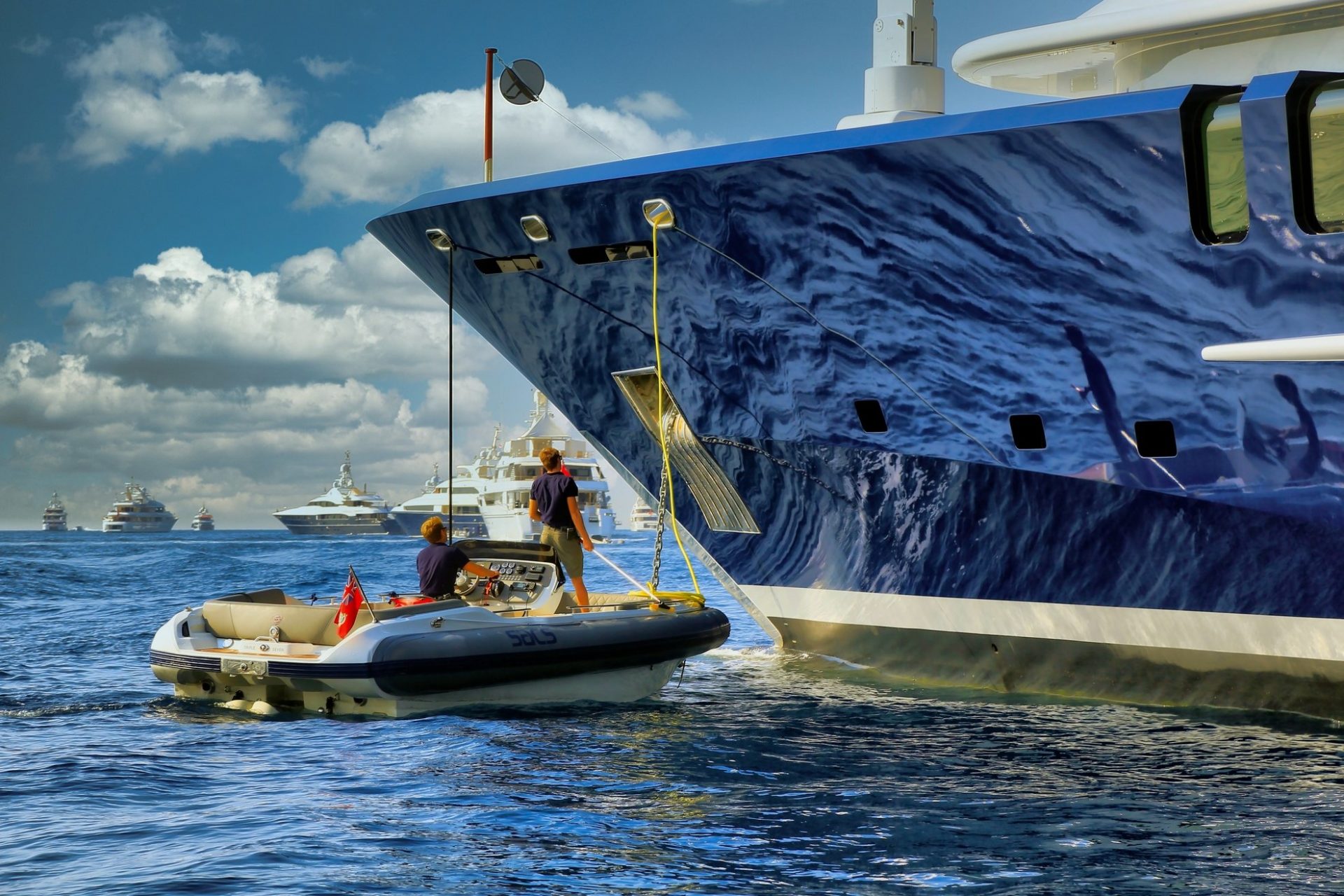
Embarking on a career as a deckhand on a superyacht offers an unparalleled blend of adventure, luxury, and the opportunity to travel the world. Whether you’re drawn to the pristine beauty of the open sea or the meticulous care of magnificent vessels, becoming a deckhand could be your gateway to an extraordinary lifestyle. This guide provides a comprehensive overview of how to start your journey, covering everything from necessary qualifications to finding work.
What Is a Deckhand?
A deckhand is an essential crew member on Superyachts, responsible for maintaining the vessel’s exterior, assisting with docking, and ensuring safety equipment is up to par. Beyond upkeep, deckhands play a significant role in guest experiences, facilitating water sports activities and managing tender operations to transport guests. With a focus on detail, physical stamina, and a commitment to service, deckhands are key to both the operational efficiency and the luxury experience on board. This position offers a unique blend of adventure and professional growth for those passionate about the industry.There is a clear pathway leading deckhands from their starting point as a junior deckhand to becoming a captain which we will cover later on.

What Does a Typical Day Usually Look Like For a Deckhand?
A typical day for a deckhand varies from boat to boat and depends if there are guests on or off.With guests on , the deck crew usually start early in the morning going around the yacht to make sure all the furniture is uncovered, decks are clean , paint is shiny and everything is looking presentable for when the guests come out.The deck crew will set up the watersports equipment and launch tenders into the water to have them ready on standby for guest operations. Throughout the day the deck crew will be on standby waiting for guest requests taking them in tenders ashore ,exploring or to carry out watersport activities which could include jetskis, sea bobs, kayaks, surfing , wakeboarding, flight boards , snorkelling, diving and much much more.
What Qualifications Do I Need To Become a Deckhand On a Superyacht?
- STCW Basic Safety Training : The cornerstone certification for maritime professionals, covering safety protocols, firefighting, and sea survival techniques.( Mandatory )
- ENG1 Medical Certificate : A health certification confirming you’re fit for sea duty.( Mandatory )
- Powerboat Level 2 / IYT Small Powerboat & RIB Master : Often required for handling the yacht’s tenders and smaller boats. ( Some yachts mave have this as a mandatory requirement )
- Superyacht Deckhand Training : ( Not mandatory but highly recommended )
- LROCP (Long Range Operator Certificate of Proficiency) VHF/HF Marine Radio Operator’s Certificate Course ( not mandatory but recommended )
Where Can I Complete The Qualifications?
STCW 95 – https://www.superyacht-crew-academy.com/
ENG1 Medical Certificate: – https://www.gov.uk/government/publications/mca-approved-doctors-overseas/mca-approved-doctors-overseas
Powerboat Level 2 / IYT Small Powerboat & RIB Master: https://www.superyacht-crew-academy.com/courses/tender-driving-iyt-rib/
Superyacht Deckhand Training: https://www.superyacht-crew-academy.com/courses/superyacht-deckhand-course/
For AMSA Medical: https://www.sonichealthplus.com.au/services/legislative-medicals/maritime
LROCP (Long Range Operator Certificate of Proficiency) VHF/HF Marine Radio Operator’s Certificate Course : https://www.superyacht-crew-academy.com/courses/vhf-marine-radio-operators-certificate/
What Transferable Land Skills Are Good To Have For a Superyacht Deckhand?
Carpentry: Carpentry skills are indispensable for maintenance and custom fittings, ensuring the yacht’s aesthetic and structural integrity. Your ability to craft and repair woodwork is crucial for preserving the luxury and bespoke nature of superyachts.
Videography & Photography: In an era where digital presence is key, your videography and photography skills can be used to document voyages and market the yacht’s charter services, enhancing its appeal to potential clients.
Diving: Diving skills open up underwater maintenance and exploration services, adding an exclusive experience for guests and ensuring the safety and cleanliness of the yacht’s hull.
Fishing: Knowledge of fishing can enhance the guest experience, offering personalised excursions and the thrill of catching fresh seafood for onboard meals.
Swimming & Surf Instructing: Proficiency in swimming and the ability to instruct guests in water sports like surfing enrich the array of activities offered, ensuring guests have a memorable and active stay.
Fitness Instructor: As a fitness instructor, you can lead personalised workout sessions, helping guests maintain their fitness routines while enjoying the luxury of the yacht.
Driving Boats: Skill in driving tenders and other small boats is essential for transporting guests, leading excursions, and ensuring the smooth operation of all water-based activities.
Painting/Varnishing: Expertise in painting and varnishing is crucial for the upkeep of the yacht’s appearance, protecting it from the elements and maintaining its value.
Watersports Instructor
Watersports instruction encompasses teaching and guiding guests in activities such as jet skiing, wakeboarding, kiteboarding and paddleboarding. For superyacht crew, being skilled in watersports instruction not only enhances the guest experience by offering fun and engaging activities but also ensures safety and confidence in the water

Can Deckhands Have Tattoos?
The yachting industry values professionalism and a certain standard of appearance. While visible tattoos may not be a deal-breaker on all yachts, they can limit your job prospects. It’s advisable to be upfront about any visible tattoos when applying for positions.
Each yacht has its own unique culture and policies, particularly when it comes to tattoos. While some yachts are more lenient, embracing both small and large visible tattoos, others may enforce strict policies against them. It’s important to be transparent about any visible tattoos you have. However, there’s no need to disclose tattoos that are not visible.
Is It Hard Being a Deckhand?
It’s not all watersports and driving multimillion-dollar tenders , there are long days of work , loads of physically demanding work and a lot of job/yacht-specific skills to learn which only comes with experience working on Superyachts.There will be a lot of working outdoors in hot weather, a lot of yacht maintenance & cleaning.There will be a lot of hard work however there are so many rewarding experiences and memories that outway by far all the hard work.Make sure you have a can-do, positive attitude and don’t be afraid to help other departments on the yacht if you have spare time , it goes a long way.
How Much Do Junior Deckhands Earn?
Salaries for deckhands can vary widely based on the yacht’s size, the vessel’s itinerary, and the deckhand’s experience.
Junior Deckhands : Starting Salary: Junior deckhands, who are just beginning their careers in the yachting industry, can expect to earn between $2,500 and $3,500 USD per month. These entry-level positions provide the foundational experience necessary for a successful career at sea.
Experienced Deckhands : Salary Range: As deckhands gain experience and demonstrate their skills, their earning potential increases. Experienced deckhands can expect to earn between $3,000 and $4,500 USD per month, depending on the yacht’s size, the complexity of the itinerary, and the specific duties they are tasked with.
Lead Deckhands : Salary Insights: Lead deckhands, who have additional responsibilities and may oversee junior deckhands, can see their salaries increase to between $3,500 and $5,000 USD per month. Their role is more demanding, requiring not only a thorough understanding of deck operations but also leadership skills.
Bosuns: Earning Potential: Bosuns, who are responsible for supervising the deck crew and maintaining the exterior of the yacht, can earn between $4,000 and $6,000 USD per month. Their salary reflects their critical role in ensuring the vessel is in pristine condition and their ability to manage the deck team effectively.
Officers: Salary Range: Officers on yachts have significant responsibilities, including navigation and safety management. Their salaries can range from $5,000 to over $8,000 USD per month, depending on their rank, the size of the yacht, and their specific duties. Chief officers, who are second-in-command, can expect salaries at the higher end of this range.
Captains: Top Earnings: Captains, who have the ultimate responsibility for the yacht, its crew, and its passengers, can earn from $7,000 USD to well over $20,000 USD per month. The captain’s salary is influenced by the size of the yacht, the complexity of the voyages undertaken, and their level of experience.
Factors Influencing Salaries
Yacht Size: Larger yachts typically offer higher salaries due to the increased workload and expertise required. Experience and Qualifications: Crew members with more experience and specialized qualifications can command higher salaries. Charter vs. Private: Crew on charter yachts might earn more due to tips from guests, whereas private yacht crew salaries are often more stable but without the added bonus of tips.
What Does The Career Progression Look Like To Go From Deckhand To An Officer ( MCA Route ) ?

How Do I Find Superyacht Job Position Listings?
The best place to look is on crew agency websites or job search platforms like Yotspot which has a large number of job listings you can look through, create a profile and update your account with your CV and all your certificates then you will be able to apply for jobs.
Below is a list of almost all the crew agencies from around the world that you can sign up with to increase your chances of landing a job. It is a lot of work creating profiles and uploading documents, however, it could increase your chances of being connected with the right job at the right time.
DOWNLOAD THE CREW AGENCY LIST

Are There Facebook Groups That Post Job Listings?
Yes, there are multiple facebook groups that post job listings all the time , it’s great to sign up with as many as you can to increase your chances of finding a job. Please note: make sure to clean up your Facebook profile before signing up to the groups as future employers may see your profile and you want to make a good first impression.
Some groups include:
Antibes Yacht crew
Palma Yacht
Australian Pacific Yacht crew

How To Become a Deckhand In Australia?
The process involves specific training and certifications, especially due to the requirements set by the Australian Maritime Safety Authority (AMSA). Here’s a step-by-step guide to help you navigate your way into this career:
1. Understand the Training Requirements
The foundational step to becoming a deckhand in Australia is to complete the necessary safety training. While the training is broadly similar across different countries, there are specific requirements for those intending to work on commercial vessels within Australia:
- STCW Basic Safety Training: This is a mandatory course for anyone working at sea, covering essential safety procedures, firefighting, first aid, and personal survival techniques. In Australia, the AMSA requires crew members working on commercial vessels to have an AMSA-compliant Certificate of Safety Training (COST).
- General Purpose Hand: The Australian General Purpose Hand Near Coastal Certificate I in Marine Operations qualification will enable you to work as a deckhand on Australian Registered commercial or private vessels
- AMSA Medical: If you wish to work on commercial vessels in Australia you will need an AMSA medical to ensure you are fit to work at sea you can find centres to complete the medical here – https://www.sonichealthplus.com.au/services/legislative-medicals/maritime
2. Choose the Right Certification for Your Career Path
Depending on where you intend to work, you’ll need to choose the appropriate certification:
- For Private and Foreign-Flagged Vessels in Australia: If your goal is to work on private or foreign-flagged vessels within Australia, you can use an MCA-approved STCW 95 certificate issued by the Marshall Islands, which SCA (Superyacht Crew Academy) offers. This certification allows you to work on private and foreign-flagged vessels in Australia, providing a pathway to gain experience before potentially heading overseas.
- For Commercial Vessels in Australia: If you aim to work exclusively on commercial vessels in Australia, such as charter boats or tour boats, you should obtain an AMSA Certificate of Safety Training (COST). This certification is specifically designed to meet the requirements for crew members on commercial vessels operating within Australian waters.
3. Gain Experience
- Start Locally: Gaining experience in Australia before heading overseas is highly recommended. Working locally allows you to understand the industry better, build your resume, and develop the necessary skills in a familiar environment.
- Consider Temp Work: Temporary positions can provide valuable experience and insight into the life of a deckhand. These roles can also offer networking opportunities, which are crucial in the yachting industry.
4. Plan Your Career Path
- Decide on Your Long-Term Goals: Whether you wish to explore international waters or prefer to stay within Australia, your career goals will influence the type of experience and certifications you should pursue.
- Continuous Learning: The yachting industry is constantly evolving, so staying updated with the latest safety protocols, regulations, and skills is essential for your career development.
Once you have completed your training sign up to as many Australian agencies as possible to increase your chances of landing a job , you can find a list of the Australian agencies below.
MARINE JOBS AYC MYS SUPERYACHT CREW CHAPMAN YACHTING SUPERYACHT CREW INTERNATIONAL CREW PACIFIC CHAMPION CREWING
What Are The Next Steps To Becoming a Deckhand?
Now you are ready to travel and become a deckhand on superyachts it is time to get certified, get all your qualifications mentioned earlier below:
- LROCP (Long Range Operator Certificate of Proficiency) VHF/HF Marine Radio Operator’s Certificate Course
Figure out where you want to look for work and head there to be based in the yacht hub to be around for interviews and networking.
Create your CV/resume and sign up to crew agencies online , creating your profiles and applying for jobs.
Attend job interviews and hopefully land your first deckhand role ( make sure to practice interview questions beforehand )
We interviewed a Superyacht captain with some really helpful advice on what to do and what not to do in interviews you can check it out below
EXPERT JOB INTERVIEW ADVICE FROM A SUPERYACHT CAPTAIN
Becoming a deckhand on a superyacht is an exciting path that offers more than just a job – it’s a lifestyle. With the right qualifications, a proactive approach to job hunting, and a commitment to continuous learning and improvement, you can embark on a rewarding Superyacht career. The world of superyachting awaits those with the courage to pursue their dreams of traveling , making good memories and friends.
Ready to Travel The World As a Superyacht Deckhand?
We have the necessary courses you need to start as an entry-level deckhand, head over to the link below for some more course information.
STCW 95+10 – https://www.superyacht-crew-academy.com/courses/stcw-95-10/
Superyacht Deckhand Course – https://www.superyacht-crew-academy.com/courses/superyacht-deckhand-course/
Superyacht Deckhand Package – https://www.superyacht-crew-academy.com/courses/superyacht-deckhand-package/
GPH ( General Purpose Hand ) – https://www.sydneymaritimeinstitute.com/deckhand-gphcourse
Best of luck with your career as a Superyacht Deckhand!
Latest News
Stay up to date.
Sign up to stay informed on our courses, dates and industry information, work opportunities and more.

Superyacht Crew Academy Provides training and certification for people who wish to work on Superyachts anywhere in the world and within the Australian Maritime Industry. Legal Name: Club Sail Pty. Ltd. Trading as: Superyacht Crew Academy Registered Training Organisation no. 91462
Unit 25a/5 Ponderosa Parade, Warriewood, NSW 2102, Australia.
+61 2 9979 9669
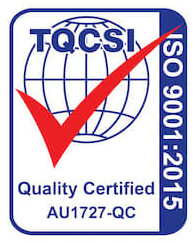)

- Career Advice
- Salary Guide
- Dockwalk Presents
- Digital Dockwalk
How to Get a Job as a Deckhand

Kate got her start in the yachting industry working as crew. She spent five years cruising the Bahamas, Caribbean, New England, and Central America, then segued that experience into a career in marine journalism, including stints as editor of Dockwalk and ShowBoats International .
A junior deckhand position is the first step in building a career that can lead to superyacht captain if you’re so inclined. Here is everything you need to know to get a foot on deck...
When you’re looking to break into the tight-knit superyacht industry with a job on deck, come prepared to work hard, take direction, and have a positive outlook.
The best candidates are keen and eager, says Marcy Laturno, executive crew placement director at Luxury Yacht Group in Fort Lauderdale. “All too often now we find entry-level crew come with their own list of demands: where the boat is going, how much time off they will get, what they expect to be paid as a minimum...”
Instead, approach your first superyacht deckhand position willing to learn and grow, and concentrate on completing a season or two on a yacht regardless of its program — private or charter, globe-trotting or more sedentary — and you’ll be on your way to your pick of positions.
What is a Deckhand?
A deckhand is responsible for cleaning and maintaining the exterior of the vessel. Led by the bosun, the deck team also assists in docking operations, launches and stows the tenders and toys , drives the tender, supervises guests’ watersports activities, and pitches in to help the interior crew after their duties are finished for the night.
Will Hollingshead, a first officer who has been hiring deckhands since his days as bosun and lead deckhand, says it’s important to have the ability to keep yourself motivated and working hard. “If I walk on deck and catch a dayworker or deckhand sneaking their phone back into their pocket or leaning back then I’ll let it slide, but if it’s multiple times a day then I’ll lose trust in that person.”
What Does a Deckhand do?
“Be prepared to clean, polish, clean, and polish some more,” says Erica Lay, director of placement agency El Crew Co in Palma de Mallorca.
How close it is to the start of a season will determine the type of work that needs to be done, says Hollingshead. “Mid winter in the Med, then you’re looking at opening up bigger projects; closer to the start of the summer it will be more teak scrubbing, stainless polishing and beautifying the yacht.”
When guests are not on board, “you will be doing the dirty work, especially if you’re junior,” says Madison Bailes, who has worked on deck of yachts spanning 116 to 350 feet. “You’re going to be cleaning the things that can’t be cleaned when the boss is on board: soaking/scrubbing cushion covers, ‘Flitz’-ing stainless, maybe detailing the engine room, paintwork, or if you’re really lucky, hanging out in a bilge,” she says with a smile. She describes this time as “chill” though — a regular eight-hour workday with a lunch break and maybe even a dock beer at the end of the day.
- Top 10 Deck Hacks for Crew
When the owner or charter guests are on board, it is a much longer and higher-pressure day. “The usual is a 13-hour workday, a three-hour break at one point and a longer eight-hour break for your main rest, though this differs from yacht to yacht,” Hollingshead says.
There is no such thing as a typical day with the boss on, Bailes says. “You could literally be in the water all day launching Jet Skis, tenders, paddleboards, doing fly-boarding and snorkeling, or you could be stood at the top of a gangway for hours watching the boss’s McLarens. I’ve done both and it all differs depending on your boat and your program.”
There will be a wider range of duties on smaller boats with fewer deckhands. On the largest superyachts, those in the junior positions may find themselves discreetly cleaning all day, while staying out of the guests’ way.
Who Does a Deckhand Report to?
On smaller yachts, a deckhand would report to the mate or directly to the captain. On larger vessels the bosun or lead deckhand is in charge of the deck team.
“The best people to work for are the ones who have the time and inclination to reach and train their junior deck crew, helping them learn how to paint, varnish, repair the yacht, etc.,” says Hollingshead.
What Qualifications do I Need to Become a Deckhand?
The prerequisites for any crew position are STCW Basic Safety Training and an ENG1 medical certificate. In addition, there are several qualifications that entry-level deckhand candidates can consider.
First of all, an RYA Powerboat Level 2 (PBL2) is what Lay calls “imperative” for working in the Med as it allows a crewmember to drive a tender in countries that require a certificate to operate small craft under 10 meters — which is most of Europe. International Yacht Training also has a course that satisfies this requirement called IYT Small Powerboat and RIB Master, which is MCA recognized.
Large motor yachts may require an MCA STCW95 certificate in Proficiency in Designated Security Duties, or PDSD for short. The one-day course is necessary for anyone with security duties on ISPS-compliant yachts, which are greater than 500 gross tons (roughly 55 meters and up).
- Everything You Need to Know About STCW Training
“Those (qualifications) are for starting out. Once a deckhand has a season or two or more under their belt and knows this is a career for them, I’d recommend they do Yachtmaster Offshore and consider looking into their EDH (MCA Efficient Deckhand), which must be held 18 months before going for OOW (Officer of the Watch),” says Lay.
In addition, Hollingshead adds, “Having a PWC license or even a PWC Instructor license is always a good short course to set yourself apart from the rest.” The RYA PWC license is a one-day course. It’s a prerequisite for the Instructor course, as is two years’ experience riding personal watercraft, which allows the crewmember to run the “RYA Introduction to PW Safety course” for guests on superyachts.
What Experience do I Need?
“Most jobs for junior crew I receive usually start with ‘must have at least a season’s experience,’ which is frustrating for the new crew to hear but sometimes we can get around that by demonstrating how transferrable their skills are from other industries or recreational activities,” Lay says.
Laturno also uses the term “transferrable” and gives some examples: “recreational boating backgrounds, skilled labor backgrounds, watersports experience, tender driving skills, to name a few.”
One way to break into crew work is by getting real-world experience in the maritime world, adds Hollingshead. “Go and get a job in a marina, work for a boat-building company, learn about teak, painting, epoxy, etc.
- 10 Tips for Newbie Deckhands
“There are two main work/life experiences that I value in a candidate,” he continues. “The first is any construction or building site experience. I grew up working on building sites with my dad and it teaches you about hard work, fixing things with the tools you have on hand, and also that most problems are solvable with a bit of forethought and working as a team. The second is anyone who has worked as a watersports instructor. I spent seven years as a windsurf/sailing instructor in Greece and Turkey before getting a job as a deckhand. When you’re hiring someone with that experience, you know they can drive a tender and that they’re comfortable on and in the water with your guests and their children.”
Bailes, who started her maritime career as a dive instructor, adds that any trade where you have acquired people skills correlates well in yachting, as does work involving cleaning, mechanics, and outdoor activities.
- How Dayworking Can Help Yacht Crew Break Into the Industry
How Much Does a Deckhand Earn?
“Starting pay for a junior deckhand in the Med is €2,500 (per month), with possibly more for skilled newbies, i.e. watersports instructors, so €3,000,” says Lay. Laturno at Luxury Yacht Group sees monthly salaries averaging $2,750 to $3,000 with the same amounts in euros.
For the ultimate answer, we turn to the Dockwalk Salary Guide , for which a dozen crew agencies around the world shared the salaries of the deckhands they placed. The numbers increase as the boat size does, and the range given for each size vessel spans various experience levels, so those just entering the industry should pay attention to the lower number. These start at $2,500 per month for boats under 80 feet, go up to $4,500 for yachts under 200 feet, and finally, $4,500 for yachts 200 feet and up.
While this may not sound like big bucks, keep in mind that a crewmember’s living expenses are close to zero so nearly all of your salary can be saved. In addition, charter yachts can offer some pretty lucrative tips on top of salaries.
P.S. A Side Note for Women
Yacht deckhand jobs have historically been dominated by men, but today more women than ever are starting their yachting careers on deck rather than inside, and gender should never be an obstacle.
Bailes, who joined the industry with a Yachtmaster license from her days on dive boats, still encountered yachts that wanted to make her a stewardess. “They see long hair and a pretty face and, boom, they want you in a skort cleaning cabins.
“While being a stew is an excellent career, if you want to be on deck, stand your ground and turn the job down if you have to,” she advises. “Do your Powerboat Level 2, not silver service, go for as many courses as you can and daywork as much as possible to gain experience. I know for a fact that I beat most guys to a job because my resume is stacked!”
More Career Guides:
- How to Get a Job as a Superyacht Captain
- Everything You Need to Become a Yacht Stewardess
- How to Land a Job as a Yacht Chef
- The Dos (and Don’ts) of Your First Crew Interview
More from Dockwalk
Most popular on dockwalk.

Impartial training and careers advice
Call us: +441983 280 641
+441983 280 641

Become a Superyacht Deckhand
- Begin a career on a Superyacht
- Career paths
A Deckhand is an entry-level position, and the role can vary from yacht to yacht. However, the first responsibility for a Deckhand is the meticulous cleaning and maintenance of the exterior of the yacht, which must be kept in pristine condition at all times.
More than that, though, working as a Superyacht Deckhand is an exciting and rewarding career kick-starter that will see you travel across the globe, make amazing new friends and gain a plethora of new skills and experiences!
If you want to become a Deckhand then click the button below and start your new career today.
However, if you’re still not sure then continue reading to find out more about working as a Deckhand on a Superyacht.
How much does a Deckhand make on a Superyacht?
A Deckhand’s salary ranges between €2,000 to €3,500 a month, though the average is €2,500. Almost all Superyachts pay is in Euros. The salary can depend on many factors, the main one being the yacht’s “crew” budget.
The owner or management company will agree on a budget that the captain uses to hire crew. Each yacht will have a different budget, which can lead to small variations in the amount yachts pay their crew.
Your total salary can also depend on whether you work on a charter or private yacht. On a charter yacht, it is customary for charter guests to tip the crew, the tip is normally around 10% of the charter fee. Chartering a Superyacht can set you back anywhere from €250,000 to €1 million per week.
Tips are split evenly between the crew and on average your tip can be anything from €2,000 – €5,000 for a week’s charter. Tips are paid on top of your monthly salary. Our guide on Superyacht salaries will explain more. Remember, you live onboard the yacht so there are very few living expenses.

What qualifications do I need to be a Deckhand?
here are three areas to consider when it comes to qualifications and experience. The first two are mandatory, the third depends on you, what work experience you have or job you have been doing to date.
- ENG 1 medical required by all crew who work at sea. If you are thinking of becoming a Superyacht Deckhand we recommend you complete the ENG1 medical before completing Step 2.
- STCW Basic Safety Training is a set of compulsory safety qualifications required by all crew in case there is an emergency onboard. STCW is a six-day course comprising; sea survival, first aid, fire fighting (great fun), and health, safety, and security.
- Get some experience we will explain more below but you don’t have to come from a yachting background to work on a Superyacht.However, it does help if you know the basics. Yachts want to see that you have a good work ethic, like the outdoors, and can get on with people.If you have a background in; hospitality, Engineering, Carpentry, Electrician, Water sports instructor, Divemaster, to name a few, then this will look great on your CV.
It is true that for any new job, the more experience and skills you can offer the better. So, if you are new to yachting and want to get qualified before heading off, we can help you get started.
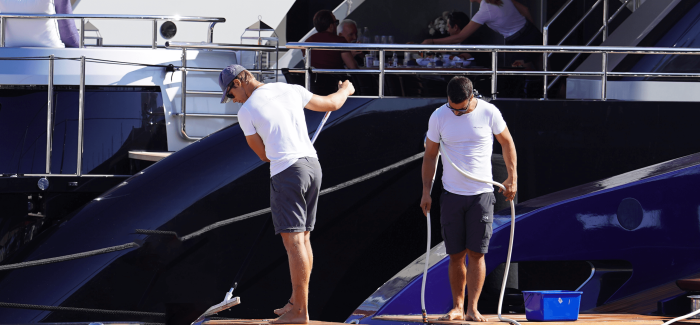
How do I become a Deckhand with no experience?
You don’t need to be a Yachtmaster or have worked on a yacht to become a Deckhand on a Superyacht. Most Superyacht crews don’t come from a boating background. Once onboard, the yacht’s crew will show you the ropes and what is expected.
However, any experience in water sports, diving, or on boats will help. Don’t worry if you haven’t worked in a practical role or been on boats.
Apart from the compulsory qualifications mentioned above, what is common among all crew is the desire to work outdoors in the sunshine.
What all Superyachts look for is a good attitude , a desire to work hard, and to be part of a team. If you have a good, positive attitude, then you can go far. Flying Fish can provide all the qualifications and skills you need to get going; all we ask is for you to provide bring a good work ethic and a positive attitude.
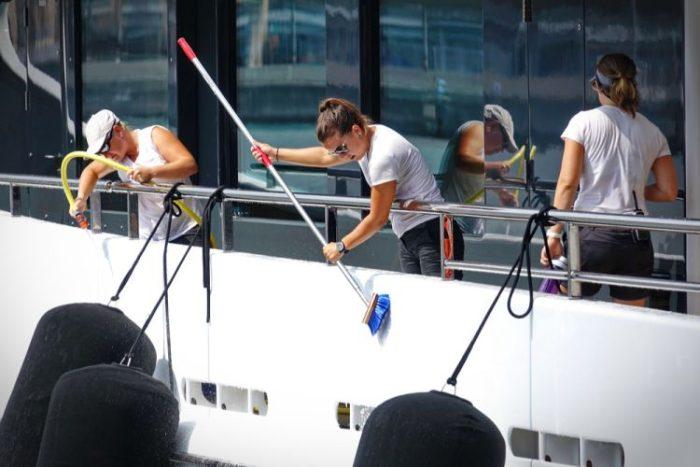
What does a Deckhand actually do?
Well, that’s hard to explain in just one article! All crew work, eat and sleep onboard, the yacht will become your home, the crew your family.
The yacht will look after you, the chef cooks all your meals while onboard. Your contract will specify your duties, salary, working hours, and holiday entitlement. The yacht will supply your uniform and provide further training if necessary.
The role of a Deckhand will vary from yacht to yacht, depending on the size, how many crew, whether it is private or charter, the owner, Captain, and many other factors. However, the deck team’s main role is the cleaning and maintenance of the exterior of the yacht and its toys.
You will be tasked with washing the yacht, cleaning the windows, scrubbing the teak decks, and polishing the stainless. When the guests are onboard you may drive the tenders, and jet-skis, help with water sports activities, and even time in the bridge on lookout duties.
What is a typical working day like as a Deckhand?
Your working day will typically start at 8:00am and finish at 6:00pm, usually six days a week. When on charter, or if the owners are onboard, your work hours will differ. Unsociable hours are common when guests are on board.
Do I live on board?
You will share a cabin with another Deckhand. The cabins are small but comfortable, with an ensuite bathroom. There is access to the internet via that yacht’s Wifi system, so you can keep in touch with friends and family at home.
How do I find work on a Superyacht?
There are three ways crew can find a job:
- Most crew travel to Antibes, France, described as the hub of yachting in the Mediterranean. The Med season runs from March through to October.
- Online, we talk a bit more about “going online” below.
- Contacts. If you know somebody already working on a Superyacht, then it is possible to find work through their connections.
Almost everybody that is looking for a job on a Superyacht travels to Antibes, France. On arrival, crew tend to stay in a crew house, such as the Crew Grapevine used as a base to look for work.
If budget is a concern, then crew join forces and rent an Airbnb between them. The advantage of a crew house like the Crew Grapevine is that the owners (ex-yachties) actively help you find a job.
The way you find a job on a Superyacht is quite unique. From your base in Antibes, you would travel to other ports in the local area, walk the dock and chat with the crew working onboard to see if any positions are available.
Superyacht crew who have the evening off will go to the local bars to unwind. This is the perfect chance to get to know people working on Superyachts and build connections in the industry.
Go online to look for a work
All Superyacht recruitment agents post positions on their respective websites. Once qualified, new, or “green crew”, as they are known, would register with the agency and complete their registration form. You would then get in touch with the agent to start searching for that dream job.
The recruitment agent’s job is to match the right candidate for the job being advertised. There are many recruitments agents out there, we work closely with YPI a Superyacht recruitment agency based in the South of France.
A quick Google search for “ Superyacht Recruitment Agents ” will bring up a list.
Yotspot is a very popular website that matches yachts with quality crew.
Facebook is another medium that yachts use to post jobs. To keep up to date, is it worth joining a couple of the Superyacht Facebook groups. Yacht crew jobs and Palma yacht group are two examples.

How long does it take to find work on a Superyacht?
Over the 12 years we have been running our Superyacht Deckhand programme, most customers find a job between one and four weeks. We have had customers that have found a job in a day and others that have taken six weeks to find that perfect job.
The time it takes to find a job is down to you. You will need to be proactive, up early, and make sure you are at the front of the queue. From our experience, people who work hard and explore every opportunity will find a job quickly.
Every Captain or Officer that calls us for a reference asks the same question – does the candidate have a good attitude? You need to be hard-working, happy to work long hours, and used to mucking in. Have a can-do attitude and a willingness to go the extra mile to help your fellow crewmates.

When is the best time to look for work on a Superyacht?
Traditionally Superyachts recruit for the Mediterranean season any time between February to May. That being said, yachts recruit all year round. We have seen many graduates find work in July and August when the season is in full swing.
The next key recruitment period is between September and November as yachts prepare for the Caribbean season. Yachts will cross the Atlantic anytime between December and January to cruise the Caribbean or the US for the winter.
Superyacht crew who have had a busy Mediterranean season may decide to take the winter off, which leaves opportunities for new crew to enter the industry.
Can I make yachting a career?
Yes! Thousands of crew who start out as a Deckhand climb the career ladder, first qualifying as a Lead Deckhand, then onto Officer and finally Captain. Okay, that sounds simple, but many have achieved their dream of becoming a Captain of a large Superyacht.
Running a yacht is not easy and requires a lot of qualifications, time at sea, excellent communication and management skills, and a deep understanding of the yachting industry.
Below is the career pathway from Deckhand to Master (Captain). The good news is there is a structured pathway, so you know what skills and sea time are required.
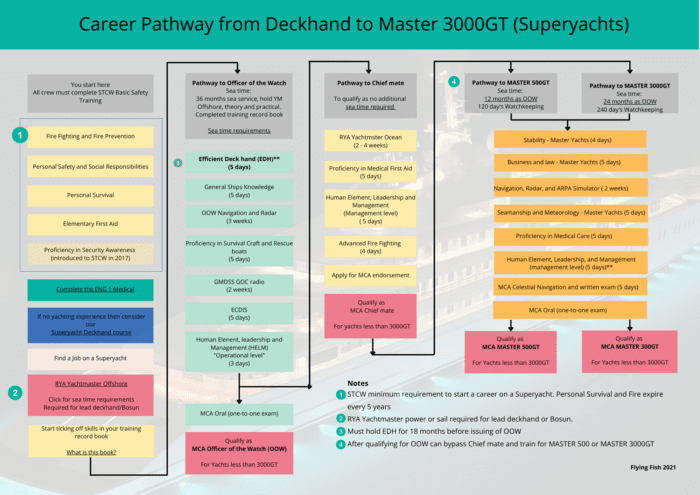
How do I become a Superyacht Deckhand?
This is where we come in. Flying Fish runs a two-week Superyacht Deckhand course that includes all the qualifications and skills you need to get started in the industry. Everything from the STCW Basic Safety Training to a bespoke programme to teach you all you need to know to get started.
The course is great fun, you will learn loads of new skills and meet like-minded people who, like you, are thinking about a different career path.
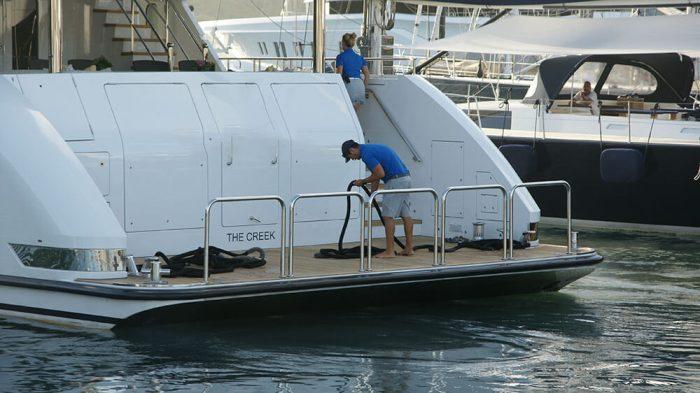
Superyacht Deckhand Course
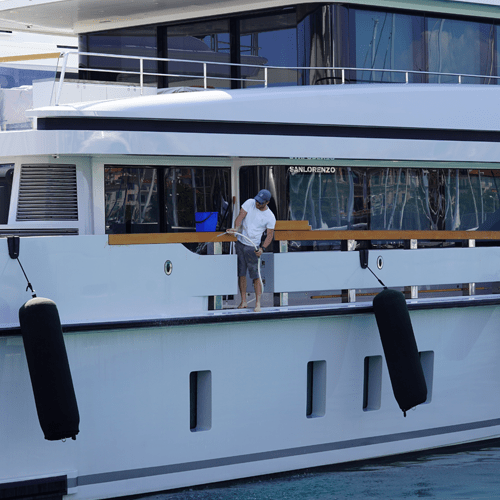
If you want to travel the world on a Superyacht, earn an enviable salary and make some incredible friends for life, becoming a Deckhand is the way to go!
The course is suitable for complete beginners or those with experience who are looking to work as a Deckhand on a commercial yacht.
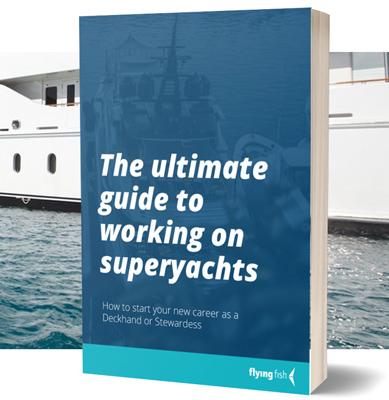
The ultimate guide to working on Superyachts

How To Become A Yacht Deckhand
If you are wondering how to become a Yacht Deckhand, then look no further.
Having been in the industry for 10 years, I know that becoming a Deckhand with no experience can be challenging.
My goal is to equip you with the knowledge and resources to secure your first job on a super yacht, regardless of your prior experience.
Table of Contents
What is a Deckhand?
A Deckhand is an entry-level role on a yacht, and their main responsibility is the maintenance and cleanliness of the exterior of the yacht.
As a Deckhand gains experience onboard a vessel they can work their way towards becoming the Lead Deckhand, Bosun, Chief Officer, and ultimately the Captain.
What is the Salary Range of a Yacht Deckhand?
The question of how to become a Yacht Deckhand is usually followed by what they earn.
A starting yacht based salary for a Deckhand can range from $2500 – $3500 depending on factors such as the size of the yacht and your qualifications and experience.
Additionally, if you work on a charter yacht you can expect to see tips of about $2000-$5000 per week of chartering.
Another important factor to consider is longevity onboard. Boats tend to reward longevity so on some vessels you can expect annual increases.

Roles and Responsibilities of a Yacht Deckhand
The primary role of a Yacht Deckhand is to clean and maintain the exterior of the Yacht. This can include a wide range of tasks such as:
- scrubbing teak
- equipment maintenance
In addition to cleaning and maintenance, a Deckhand will also assist with:
- mooring operations
- tender operations
- guest activities
- water sports
- bridge lookout
- any assistance required in the daily operations of the yacht.

Mandatory Qualifications for Becoming a Yacht Deckhand
If you are looking to become a superyacht Deckhand, you will need to have an STCW Certification and pass an ENG1 medical.
The STCW (Standards of Training and Certification of Watch keeping) is an internationally mandated course and a minimum requirement for anyone who wishes to work on a yacht. During the training, crew members will learn basic safety skills and acquire knowledge to effectively handle emergency situations onboard. The training will also cover basic safe working practices to ensure the safety of all crew members.
In 2010 the STCW convention added a new module requirement to the basic safety training, so ensure that you do the additional Proficiency in Security Awareness (PSA) module which takes one extra day.
This STCW course is comprised of 4 modules, takes 5 days to complete, and is valid for 5 years. The modules include:
- Personal Survival Techniques (PST)
- Fire Fighting and prevention (FFP)
- Elementary First Aid (EFA)
- Personal Safety and Social Responsibility (PSSR)

An ENG1 is a basic medical examination carried out by an MCA (Maritime Coastguard Agency) certified doctor, confirming that you are in a fit condition to work on a yacht.
Without passing this medical check, you will not be able to work on a yacht as a Deckhand.
Ensure you book your medical with an MCA-approved doctor .
Recommended Additional Courses for Becoming a Deckhand on a Yacht
It is important to note that the required deckhand qualifications may vary depending on the size and type of the Super Yacht and the flag state under which it operates.
Some super yachts may have additional requirements beyond the ones mentioned above.
Proficiency in Designated Security Duties (PDSD)
The PSA course has already been completed as a minimum requirement in your STCW course. However, crew members given designated security duties under the ship’s security plan must complete this PDSD course.
This requirement is for vessels that fall under the ISPS code (International Ship and Port Facility Security Code).

Power Boat Level 2
This yacht deckhand course is essential if you are seeking a qualification to operate yacht tenders. Doing this course is also the foundation for what you will be learning in courses to come as you climb the ranks and gain more certifications.
Another equivalent course is the IYT Small Powerboat & Rib Master which is also recognized by the MCA.
In this 2-day course, you will learn:
- Basic collision avoidance regulations
- Basic navigation, actions in emergencies
- Safety equipment
- Boat handling skills
- Berthing alongside
- Turning in a confined space
- Man-overboard drills

VHF Short Range Radio Course
The VHF radios are used on a vessel for communication between the main vessel and small crafts, other vessels, or land-based authorities within the area.
Therefore, if you have crew or guests out on the tender or beach, or if your vessel is coming into port, you will be using the VHF radio to communicate.
This is a required course for some of your upcoming certifications, so it is advisable to get it done now. It is also legally required to obtain this certificate on certain vessels if you are a crew member who will be using VHF communication.
In this one-day course, you will learn the correct voice procedure, the GMDSS system, the phonetic alphabet, emergency calls, and the DSC controller
Personal Watercraft License (PWC)
A personal watercraft refers to the Wave runners and Jet skis of a vessel. If you want to become a Yacht Deckhand, certain cruising areas will require you to hold this license in order to operate the Jet skis. Therefore it is recommended that all Deck crew members hold this license.
In this one-day course you will learn:
- Recovery skills
- Passage planning
- Decision-making
- High and low-speed riding skills
- Essential safety information
- Collision avoidance
- Orientation at sea

Recommended Courses to Consider as You Climb the Ranks
Mca yacht rating.
The Yacht Rating Certificate is required by Yacht Crew members to be part of the safe manning requirements of the vessel. There are 2 ways to attain this certificate as per the application form :
1. With a training record book
Applications for a Yacht Rating Certificate require at least 6 months yacht service, including 2 months actual sea service on vessels over 15m in load line length plus a completed Yacht Rating Training Record Book .
2. Complete a course
If you choose to complete a course, successful candidates will receive a Course Completion Certificate. They will then apply to the MCA, and obtain the MCA Yacht Rating Certificate after completing two months of sea service on vessels of over 15m in load line length. Course choices include:
- Watch Leader Certificate together with an RYA Competent Crew Certificate
- Day Skipper Certificate with an RYA Competent Crew Certificate and/or higher RYA Certificate
- Yacht Rating Course Completion Certificate
The benefit of holding this certificate is that it informs Captains that you have advanced deck skills. Additionally, this course is a good introduction for students who want to do the EDH (Efficient Deckhand Course).
This 5-day Training Course Covers:
- Navigational Watch Duties
- Life-Saving and Fire Fighting Equipment
- Code of Safe Working Practices
- Engine Watch Keeping Duties
- Pollution Prevention
- Knots, Bends, and Hitches
- Whipping and splicing
- International Safe Management Code
- Rules of the Road
- Lights and IALA A and B Buoyage system

Efficient Deckhand Course (EDH)
The importance of obtaining this certificate when you meet the pre-requisites is that you need to hold your EDH for 18 months before you can start your OOW course.
The Efficient Deckhand (EDH) course covers basic seamanship, tying of knots, and advanced rope work such as whipping, splicing, and rigging. It also teaches maintenance routines, steering, duties of the lookout, and the responsibilities of crew members under the Code of Safe Working Practices for Merchant Seamen.
This course is taught over 4 days with an oral and practical examination on the last day. I recommend you arrive with the ability to tie most of the standard nautical knots in order to get through the syllabus.
The pre-requisite for the course is to hold a Yacht rating with 6 months of seagoing service and a steering certificate.
Update your Yachting CV
It is crucial to have an impressive Yacht CV that catches the attention of the Captain and motivates them to read it thoroughly.
You may be wondering how to become a Yacht Deckhand without any prior experience. You will be competing with numerous crew members who may have an edge over you with their courses and experience.
Follow my Yacht CV guidelines to highlight your skills and attributes that will make you a standout candidate for the job.
Locate Yourself in a Yachting Hub and Apply for Deckhand Jobs
When you go dock walking , be sure to do your research before heading out. Take into account factors such as the time of year and port control regulations.
Some locations to consider include:
The best time of year to seek work in America would be starting in October for the Caribbean Season .
Please note that it is ILLEGAL to dock walk in America unless you are an American Citizen or green card holder. Fort Lauderdale is the best place to be based if you are legally allowed to dockwalk.
If you are looking to find work on a yacht for the Mediterranean yachting season , you should head over in March.
In Italy, you want to head to Monaco, Genoa, Loana, Imperia, or San Remo
In the South of France, Antibes is your best option, but others you could try are Toulon, Nice, Cannes, and La Ciotat.
If you head to Spain, you want to be based in Palma de Mallorca or Barcelona.
Sign up with Yacht Crew Agencies
You will want to sign up with as many crew agencies as possible if you want to become a Deckhand on a Yacht.
Here are some popular agencies you should sign up with to get started:
- Luxury Yacht Group
- Blue Water Yachting
- The Crew Network
- Cotton Crews
- Northrop and Johnson
Don’t forget to keep an eye on Facebook and other social media platforms for Deckhand job postings. Join yachting Facebook groups like Fort Lauderdale Yacht Crew, Palma Yacht Crew, Antibes Yacht Crew, and any others that may have Deckhand job opportunities available. Check these groups regularly to stay updated.
Gain Deckhand Experience Wherever Possible
Don’t be afraid to accept day work on boats of all sizes. Some day work may not be on your vessel size of choice, but you want to gain experience on deck regardless.
Be sure to work hard and impress the Captain and Crew, as you will be wanting a good reference from them.
Final Thoughts on How to Become a Yacht Deckhand
Never forget that every Captain was once a Deckhand…
Working out on deck can be tiring, and you’ll need to put a lot of personal time and money into your courses and certifications.
Enjoy the experience of being a Deckhand, all the fun, laughter, hard work, and challenges that come with it. The yachting industry is a worthwhile adventure, and becoming a Deckhand on a Yacht is just the first step in your journey to some epic opportunities.

Hi, my name is Lisa, a Chief Stewardess in the yachting industry with 10 years of experience, as well as 8 years of hospitality experience prior to that. Being in the yachting industry has been a whirlwind of adventure, growth, challenges and some of the best experiences of my life, and I am excited to share my knowledge and experiences with all of you.
How to Become a Superyacht Deckhand
So you want to be a superyacht deckhand.
A deckhand is the entry level for almost all professional crew jobs on superyachts. The superyacht industry relies heavily on skilled deckhands to keep the world’s most luxurious yachts looking stunning.
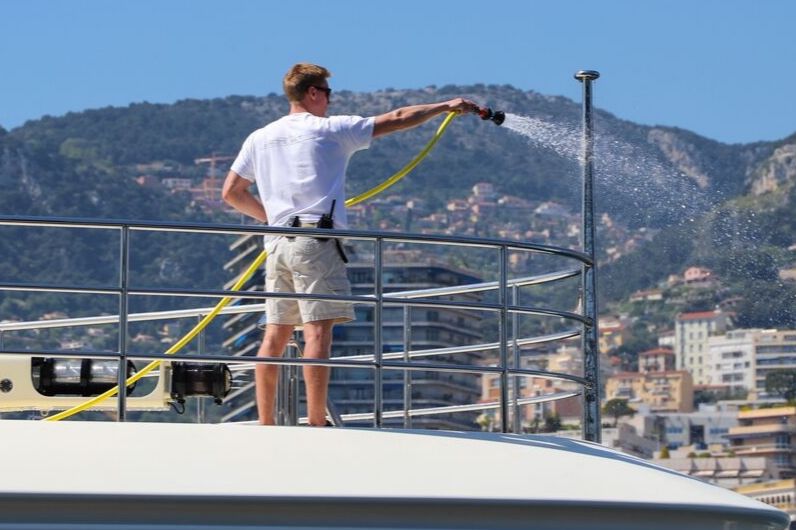
Job role of a Superyacht Deckhand
The deckhand position will encompass many responsibilities, but most importantly, he/she will maintain the exterior of the yacht and keep it in pristine condition at all times.
Covering everything from the windows to sporting equipment, from changing sun lounger covers to varnishing the guard rails. You will also help with mooring and tender handling.
You could be the only deckhand on board, but on larger superyachts there may be as many as five or more deckhands working.
The deckhand’s role is incredibly varied, tasks include;
- Fibreglass restoration
- Line handling
- General exterior maintenance
- Driving tenders
Personality traits
Working onboard a superyacht means you’ll have to demonstrate a professional, hardworking attitude at all times. You will need to be motivated to complete all tasks to the high standard expected. Typically your working day will start early, and finish late, so you’ll need to be energetic, enthusiastic and physically fit.
Skills required to become a superyacht deckhand
Deckhands do not have to have boating qualifications but having them is an asset. General seafaring skills are expected. Deckhands should ideally have some knowledge and experience of navigation, boat handling, engines and radio equipment. Any skills or experience in any of the above mentioned tasks would be a distinct advantage.
But if you’ve never worked on a yacht before, it doesn’t mean that you are unsuitable for consideration. Captains hire crew with a variety of backgrounds, such as, hospitality and hotels, tour leaders, cruise lines, graduates, engineers, mechanics, divers and anyone who can prove they have a good work ethic and a willingness to learn. If you’re interested in gaining a deckhand qualification, check our our superyacht deckhand course .
Superyacht deckhand salary
What are the benefits of working as a deckhand.
For this entry-level role, you will earn a great wage of on average €2,000-€2,500 per month (tax-free), often with generous tips on top! With clear career progression along a structured route to become a Superyacht Captain, there’s plenty of opportunity to make this a rewarding, lifelong career.
Superyacht job salary ranges
So just how much can you earn while working on a superyacht? The following table shows salary ranges, tax free and not including tips.
| Job role | Low | High |
|---|---|---|
| Experienced Deckhand | €2,500 | €3,000 |
| Junior Deckhand | €2,200 | €2,500 |
* These salary guidelines are based on the current yachting market as of January 2018. Actual salaries will always vary depending on a candidate’s specific experience, training, certification, and additional skills – as well as a particular yacht’s needs. Data provided by Camper & Nicolson International
Register your interest
- First name *
- Last name *
- How did you hear about UKSA? * –None– Campaign Dinghy Show Educational Visits UK Event GroupAccommodation.com Guardian Media IOW College IOW County Press London Boat Show Online PlanMySchoolTrip.co.uk Press Radio Referral School Travel Organiser Social Media Southampton Boat Show Top School Trips UKSchoolTrips.co.uk Visit IOW Yachts & Yachting
- General notes
- Opt-in to receive course information and relevant offers
- Accept Privacy Policy and Terms and Conditions .
- Name This field is for validation purposes and should be left unchanged.
Courses you may also be interested in

If you have any questions or need to get in touch:
Speak to UKSA on +44 (0)1983 294941 or email us

Setting Sail to Success: A Guide to Becoming a Successful Deckhand and Building a Rewarding Maritime Career
- June 23, 2023
Imagine standing on the deck of a ship, feeling the ocean breeze on your face and the rolling waves beneath your feet, as you embark on an exciting journey across the vast seas. If this sounds like a dream come true, then a career as a deckhand might be the perfect fit for you. In this article, we will guide you through the essential steps to become a successful deckhand, from acquiring the necessary skills and qualifications to building your professional network in the maritime industry. We will also share valuable tips for landing your first deckhand job on a vessel and discuss opportunities for growth and development in this rewarding career. Lastly, we will address the importance of staying safe and adapting to life at sea as a deckhand. So, get ready to set sail on a thrilling adventure as we navigate the path to becoming a deckhand.
1. Essential Skills and Qualifications for a Successful Deckhand Career
Embarking on a career as a deckhand requires a specific set of skills and qualifications to ensure success in this demanding profession. One of the most crucial abilities is having a strong work ethic, as deckhands often work long hours in challenging conditions. Additionally, being a team player is vital, as deckhands must collaborate with other crew members to maintain the vessel and ensure smooth operations. Physical fitness is also a significant factor, as the job entails heavy lifting and manual labor. Furthermore, possessing excellent communication skills and a keen attention to detail will help you excel in this role.
When it comes to qualifications, obtaining a STCW (Standards of Training, Certification, and Watchkeeping) certificate is essential for working on commercial vessels. This internationally recognized certification covers basic safety training, first aid, and firefighting. Additionally, having a Powerboat Level 2 license or a Yachtmaster qualification can be advantageous, as it demonstrates your competency in operating small vessels. While there are many pros to a deckhand career, such as the opportunity to travel and work in a dynamic environment, it’s essential to consider the cons, such as the physical demands and long hours away from home. Ultimately, a successful deckhand career requires dedication, hard work, and a passion for the maritime industry.
2. Acquiring the Necessary Training and Certifications for Deckhands
Before you can begin your journey as a deckhand, it’s essential to acquire the appropriate training and certifications. Many maritime schools and training centers offer courses specifically designed for aspiring deckhands. These courses typically cover essential skills such as knot tying, line handling, safety procedures, and basic navigation. Additionally, you may want to consider taking specialized courses in areas such as firefighting, first aid, and personal survival techniques.
When it comes to certifications, there are a few key ones that you’ll need to obtain to work as a deckhand. These include:
- STCW (Standards of Training, Certification, and Watchkeeping) Basic Safety Training: This internationally recognized certification covers basic safety training in personal survival techniques, fire prevention and firefighting, elementary first aid, and personal safety and social responsibilities.
- ENG1 Medical Certificate: This certificate confirms that you are medically fit to work at sea and is required by most employers.
- Proficiency in Designated Security Duties (PDSD): This certification is required for crew members with specific security responsibilities on board a vessel.
Once you have completed the necessary training and obtained the required certifications, you’ll be well-prepared to start your career as a deckhand. Networking and gaining practical experience through internships or entry-level positions will also be crucial in helping you secure a job in the industry. Remember, becoming a successful deckhand takes time, dedication, and a willingness to learn and grow in your role.
3. Building Your Professional Network in the Maritime Industry
In order to become a successful deckhand, it is crucial to build a strong professional network within the maritime industry. This can be achieved by following these steps:
- Attend industry events such as conferences, workshops, and seminars to meet like-minded professionals and learn about the latest trends and opportunities in the maritime sector.
- Join professional associations and organizations related to the maritime industry, as they often provide networking opportunities and access to valuable resources.
- Utilize social media platforms like LinkedIn to connect with professionals in the industry and showcase your skills and experience.
- Consider volunteering or interning with maritime companies or organizations to gain hands-on experience and make valuable connections.
- Don’t be afraid to reach out to professionals you admire for advice or mentorship, as they can provide invaluable insights and guidance on your career path.
By actively engaging in these networking activities, you will be better positioned to find job opportunities and establish a successful career as a deckhand in the maritime industry.
4. Tips for Landing Your First Deckhand Job on a Vessel
Securing a position as a deckhand on a vessel can be a challenging yet rewarding experience. Networking is crucial in this industry, so make sure to attend boat shows, yacht clubs, and marinas to meet potential employers and other professionals in the field. Additionally, consider joining online forums and social media groups related to the maritime industry to expand your network and stay informed about job opportunities.
Obtaining relevant certifications can significantly increase your chances of being hired as a deckhand. Some of the essential certifications include the Standards of Training, Certification, and Watchkeeping (STCW), and the Powerboat Level 2 certificate. Additionally, having a strong background in water sports, such as sailing or diving, can be a valuable asset. Remember to highlight these skills and certifications on your resume and during interviews.
Lastly, gaining hands-on experience is vital for aspiring deckhands. Volunteering on boats or working at marinas can provide you with practical knowledge and skills that will be useful in your future career. Moreover, these experiences can serve as excellent references when applying for deckhand positions. Be prepared to start at an entry-level position and work your way up, as this will demonstrate your commitment and passion for the maritime industry.

5. Advancing Your Deckhand Career: Opportunities for Growth and Development
As a deckhand, it is essential to continuously improve your skills and knowledge in order to advance in your career. One way to achieve this is by attending specialized training courses and obtaining relevant certifications. For instance, you can pursue courses in navigation, marine engineering, or even yacht management. Additionally, participating in workshops and seminars related to the maritime industry can help you stay updated on the latest trends and best practices. It is also crucial to network with professionals in the field, as this can open up new opportunities for growth and development.
A checklist for advancing your deckhand career may include the following items: obtaining necessary certifications, attending training courses, participating in industry events, networking with professionals, and gaining experience in various roles on board. By focusing on these areas, you can enhance your expertise and increase your chances of securing higher-level positions, such as a bosun, mate, or even captain. Remember that hard work, dedication, and a willingness to learn are key factors in achieving success in the maritime industry.
6. Staying Safe and Adapting to Life at Sea as a Deckhand
Adapting to life at sea as a deckhand requires a strong focus on safety and the ability to quickly acclimate to the unique challenges of working on a vessel. One of the most crucial aspects of staying safe on board is having a thorough understanding of the ship’s safety procedures and equipment. This includes knowing the location and proper use of life jackets, life rafts, fire extinguishers, and emergency signals. Additionally, it is essential to participate in regular safety drills and maintain a checklist to ensure all safety equipment is in good working order.
Physical fitness and stamina are also vital components of a deckhand’s ability to stay safe and adapt to life at sea. The demanding nature of the job requires long hours of manual labor, often in challenging weather conditions. Regular exercise, proper nutrition, and adequate rest are essential for maintaining the physical and mental resilience needed to perform at a high level. Furthermore, it is crucial to be aware of one’s surroundings and maintain clear communication with fellow crew members to prevent accidents and ensure the smooth operation of the vessel.
Lastly, adapting to life at sea as a deckhand involves developing a strong sense of camaraderie and teamwork with fellow crew members. Living and working in close quarters can be challenging, but it is essential to maintain a positive attitude and foster a supportive environment. This includes respecting the privacy and personal space of others, being willing to lend a hand when needed, and actively participating in shared responsibilities such as cooking and cleaning. By cultivating a strong sense of teamwork and maintaining a focus on safety, deckhands can successfully navigate the challenges of life at sea and excel in their roles.
Frequently Asked Questions
1. what are the typical daily tasks of a deckhand, 2. how long does it take to become a qualified deckhand, 3. what are the physical requirements for a deckhand, 4. are there any specific certifications required to work as a deckhand, 5. what is the typical career progression for a deckhand.
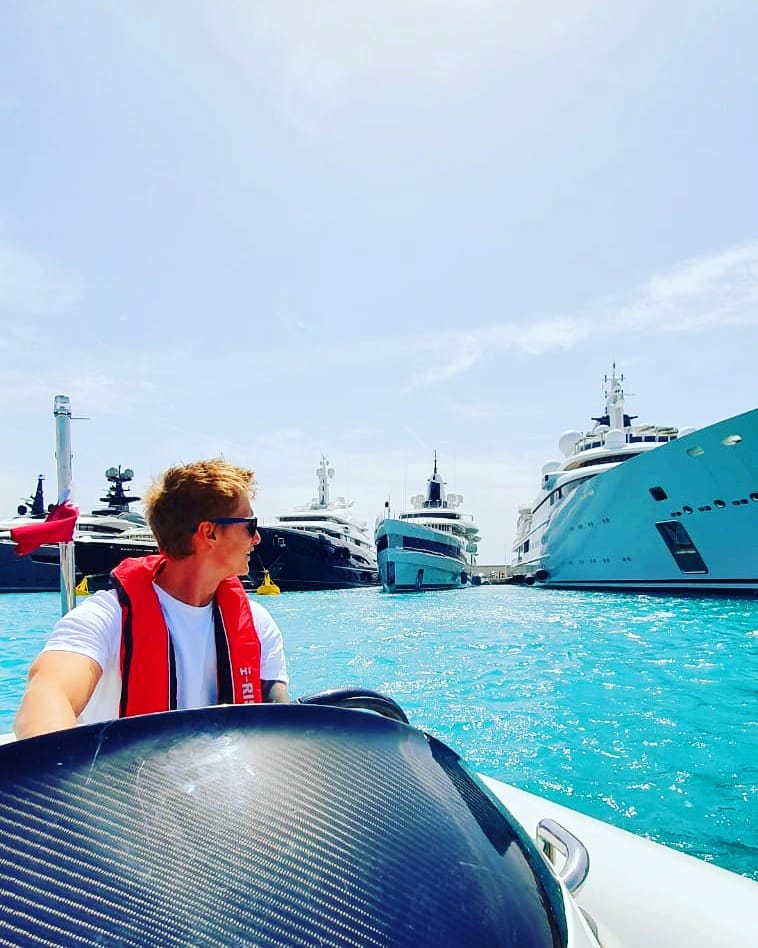
Yacht Deckhand Premium STCW

Yacht Stewardess Premium STCW

Yacht Stewardess Full STCW
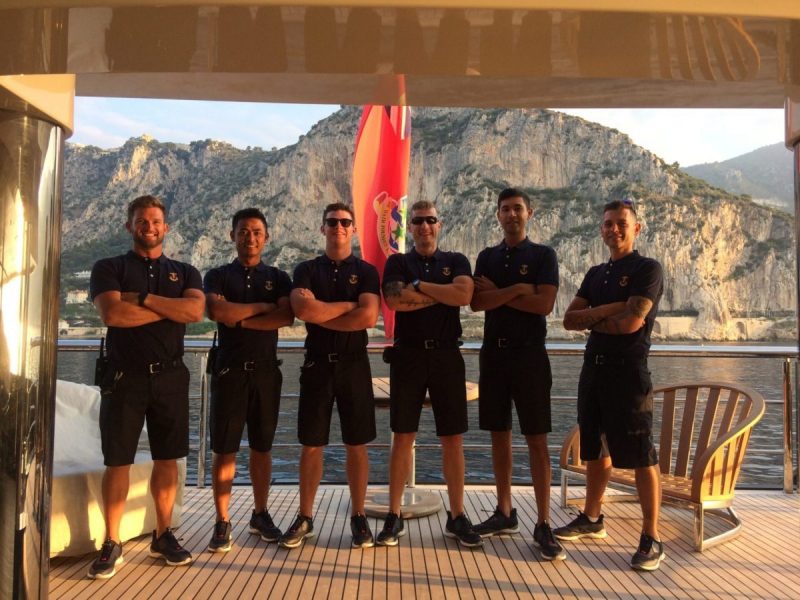
Superyacht Deckhand Full STCW

Top 10 best places to find a Yacht job in the Med 2024?

Exploring Yacht Stewardess Training in Fort Lauderdale: A Comprehensive Guide

All You Need to Know About Yacht Stewardess Training in United States

Yacht Stewardess Training in Florida: Launch Your Yachting Career

Understanding Food Hygiene Level 2 For Yacht Crew

An Ultimate Guide to ENG1 Medical Certificate for Yacht

STCW Basic Safety Training United States
Superyacht crew training europe.
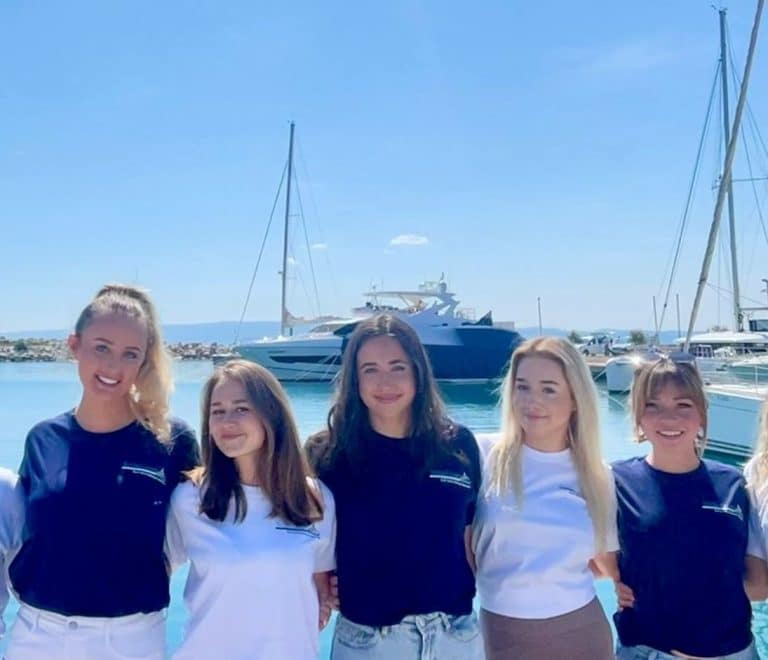
July Training Fully Booked – 3 Spots left for August
Get free yacht cv and yacht job offers

Superyacht Deckhand Duties
Deckhand duties overview.

A deckhand is the lowest-ranked crew member in the deck department. The deck department is responsible for the exterior maintenance of the vessel as well as vessel operations such as docking, anchoring and navigational watches. Superyachts operate on a hierarchical system and the deck department is no different. Depending on the size of the yacht, the deck team can be made up of a captain, officers, a bosun, senior/lead deckhands, standard deckhands as well as junior deckhands. This page focuses on the role of a superyacht deckhand and/or junior deckhand.
Your duties and responsibilities as a deckhand will vary greatly depending on the size of the yacht and how many deck crew members are employed on the vessel. Inexperienced deckhands will spend a great deal of time with cleaning and maintenance duties, such as washing the boat, cleaning windows, polishing stainless steel and scrubbing decks. During guest trips, more time will be spent on lookout duties, tender driving, running watersports activities, while at the same time ensuring normal vessel operations and cleanliness are adhered to. Different size yachts and guest types result in differing roles, responsibilities and lifestyles, all of which have their pros and cons. Larger yachts generally have a more structured and hierarchical approach to duties, whereas smaller vessels have a more "do it all" approach. It is important that no matter the type of vessel you work on, activities are being performed in a professional following safe working practices.
Deckhand Duties Vary, Depending on Operational Activities
- On Season Guests on
- On Season Guests off
- Off Season / Yard Period
- Ocean Crossings
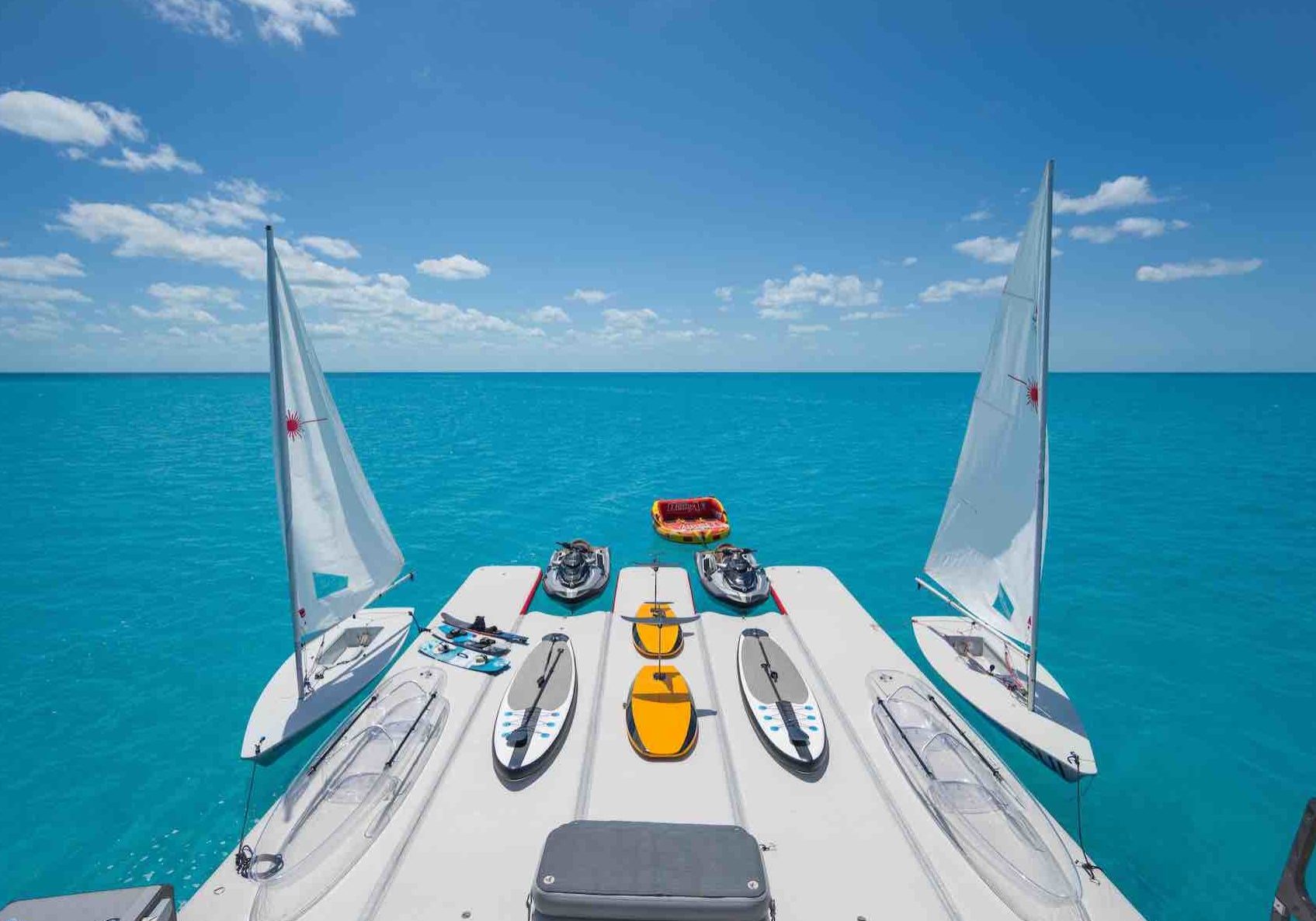
Time off is generally limited with long periods of work. Work schedules are generally more structured on larger vessels as there are generally sufficient hands on deck for most operations to take place. Be aware that there are times that your break will be cut short depending on the operations of the vessel. The crew need to be more flexible on smaller yachts as the schedule will have to be structured around demanding guests. Generally, a watch system will be in place for the duration of the guest trip. The watch system will include an anchor and cruising watches, as well as a daily working schedule (for day and night). If you have a break, you will generally not be allowed off the yacht (with guests onboard).
Guest trips can be long and demanding but can also be a great deal of fun. It is important to remain professional, calm and positive. Your attitude towards other crew and guests can have a significant impact on the success of a charter.
Depending on the yacht, the itinerary and the guests, the job can involve a lot of time driving tenders, giving you the opportunity to explore sections of the coastline.
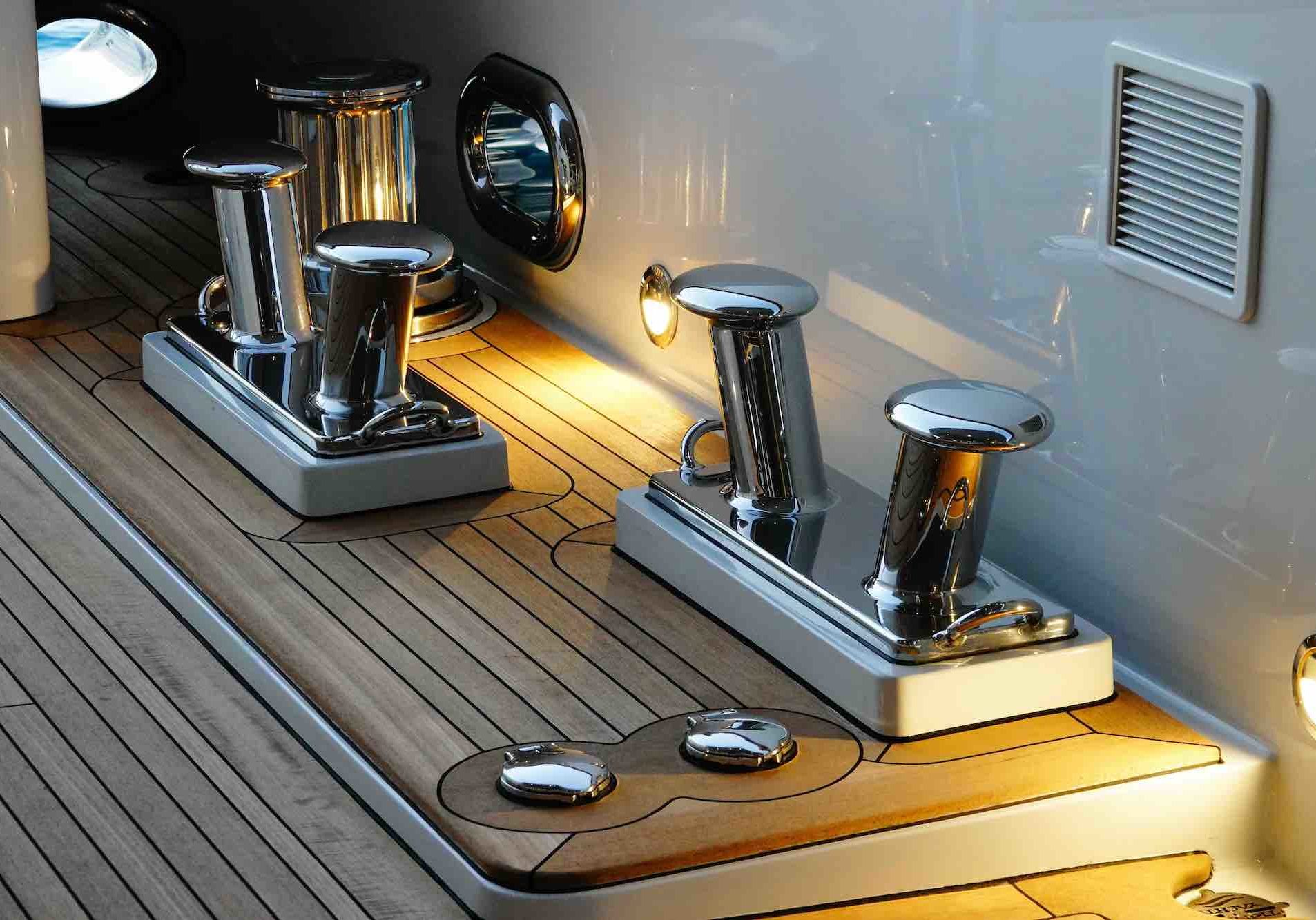
Guest areas to remain clean and presentable at all times appropriate!
This involves:
- Covering up furniture in the evenings and during spells of bad weather
- Cleaning tables, cushions as well as marks off of the teak (usually from food, drinks and sunscreen).
- Rinsing or washing areas once guests have gone to sleep
- Reopening furniture prior to guests waking up and ensuring that the teak, tables and stainless steel rails are dry with no hand or water marks. - Breakfast areas are often the priority as it is generally not acceptable to clean while guests have entered the area.
- Rinsing and washing the vessel after passages that spray the vessel with salt
- Tenders, swim platforms, towels, water sports equipment need to be presentable and ready to go at a moments notice.
Guests off (In season):
- Most yachts work Monday to Friday with weekends off, if the schedule allows .
- During this period, the yacht will be detailed and prepared for guest arrivals.
- In some cases where there is a significant period between guest trips, some larger jobs can be addressed; such as varnishing, minor paint jobs and repairs.
- In the case of charter boats or busy private yachts, the turnaround period between guests can be as little as 1-2 days. In this case, your duties will be washing the boat down while helping the interior crew get provisions and supplies onboard.
- When guests are not on board, the crew have a rotating watch system in place. This will require you to remain on the vessel for the assigned period to ensure the safety of the yacht. This may result in you being left on watch during your day off.

Off-Season:
- Most yachts work Monday to Friday with weekends off, if the schedule allows.
- Some crew will be granted leave or vacation during this period.
- The yacht will be tied up at the dock or taken out of the water and all furniture, toys and equipment will be covered and stowed.
- The yard period is an extremely important time for the vessel as it is often the only opportunity to do significant maintenance work. It is also a fun time for the crew as you will usually get evenings and weekends off to explore the location in which you are situated.
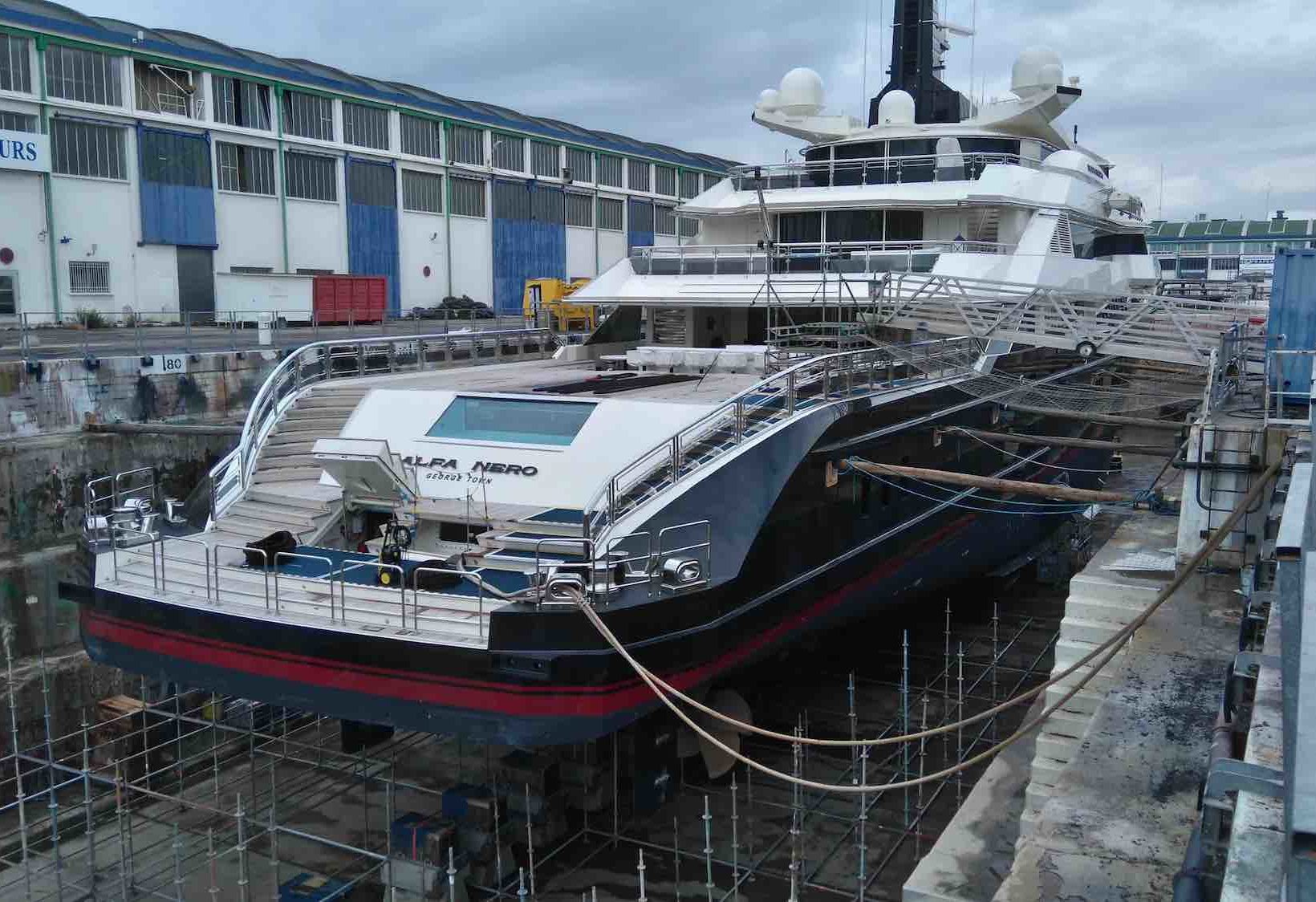
- Typical jobs for deck crew during this time may include sanding, painting, varnishing, rust removal, painting anchor chains, basic carpentry, doing inventories and cleaning out locker storages. It is also a great time for experienced crew to train and teach new crew useful skills and drills.

Crossing / Deliveries:
- Many superyachts do dual seasons and therefore spend long periods crossing to their next seasonal destination. The most common crossing is the Atlantic crossing between Europe and the Caribbean/USA which takes + - 2 weeks depending on the vessel and the conditions.
- It is extremely unlikely to have guests onboard and therefore it is usually only crew on board for these passages.
- The boat is stowed for the worst possible seas and prepared for extremely rough conditions.
- Your role on these passages as a junior deckhand or deckhand will be that of a lookout, meaning you will be on the bridge with the watchkeeper assisting in lookout duties. It presents a great learning opportunity and allows you to start taking part in bridge and navigation activities under the supervision of an officer.
- Watch-keeping hours will vary depending on the size of the vessel but are a maximum of four-hour shifts.
- In addition to your watch-keeping duties, you may have a work-list of jobs to get through. Getting the vessel to the next destination safely is the main priority and most captains try to avoid overworking crew before a busy season ahead. Activities that have a potential injury risk associated with them will be avoided at all costs.

Work Intensity
The workload onboard varies depending on the yacht, season, itinerary and whether or not there are guests onboard. The busiest times are usually the end of yard periods, preparing for a season, boat shows, as well as during guest trips. During guest trips, 7-day weeks and 12 - 14 hour days can be expected.
Below is a very broad and generalised schedule to give you an idea of what to expect once you step onboard:
Deckhand Duties Familiarization Videos:
Find out about your duties in order to give you a head start before joining a vessel as a deckhand.
How to Wash Down Correctly:
When and How to Rinse
Username or Email Address *
Remember me Lost your password?
Username or Email
Get New Password
Got a Question?
Complete our short form for a prompt response and world class tax advice.
Yes please contact me regarding mortgages
By selecting this, you agree to the Privacy Policy .
Sign in to your account
How to become a yacht deckhand.

If you wish to embark on a career in yachting, your starting point is to get a job as a junior deckhand.
From then on you can hope to climb further up in the career ladder.
One thing is for sure - you need to have a positive outlook and be willing to learn and to work hard.
It may be a struggle at first, but you should never give up.
The following tips will help you set out on the right track!
What is a Deckhand?
Yacht deckhand responsibilities, yacht deckhand salary ranges, is income from yachting tax free, skills & experience, can i become a yacht deckhand with no experience, eng 1 medical, stcw basic safety training, previous experience, update your cv, prepare for interviews, register at yachting agencies, go dockwalking, find daywork, adapt & learn.
First of all, let us explain what the position of a deckhand actually entails .
A deckhand will mainly be responsible for the cleaning and maintenance of the yacht.
As a deckhand you will be focusing on the exterior of the yacht, and you will also be expected to assist in the various docking operations.
These include launching, stowing and driving the tenders, supervising water sports activities, as well as assisting the interior crew if the need arises.
The deckhand will be led by the bosun or lead deckhand.
On a smaller vessel, the deckhand might report directly to the captain.
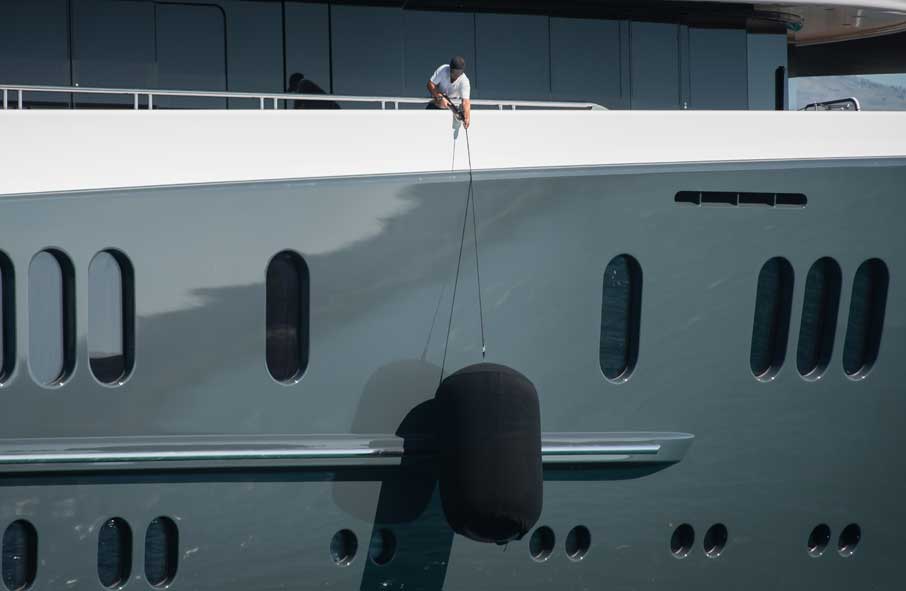
A yacht deckhand’s duties are quite varied, and one cannot really expect to have the same duties every day.
Duties differ according to the vessel and the program, as well as the number of deckhands present aboard the yacht.
Whenever there are guests on board, the day is bound to be longer and more diversified in terms of deckhand duties.
Typically, if a deckhand is working on a relatively small boat, there will be fewer deckhands, and so the range of duties he will be entrusted will be more diversified.
Some of the most common tasks that a deckhand will be doing include :
- General maintenance of yacht exteriors
- Operation and maintenance of jet-skis, toys and tenders
- Driving tenders and/or toys
- Helping with water sports activities
- Lookout duties
| €4,000-€10,000 | €7,000-€16,000 | €14,000+ | €16,000+ | |
| €3,000-€5,000 | €4,300-€5,700 | €6,000+ | €7,000+ | |
| €3,200-€4,500 | €4,000 | €5,000 | ||
| €3,000-€4,500 | €4,000-€6,000 | €6,000+ | €7,000+ | |
| €2,800-€3,000 | €2,800-€3,500 | €3,500+ | €4,500+ | |
| €2,800-€3,500 | €2,800-€4,000 | €3,500+ | €4,500+ | |
| €2,000-€3,000 | €2,000-€3,000 | €3,000+ | €3,000+ | |
| €2,000-€3,000 | €2,000-€3,000 | €3,000+ | €3,000+ | |
| €3,000-€4,500 | €4,000-€7,000 | €6,000+ | €7,500+ |
As a general rule of thumb, the starting pay for a junior deckhand is around £1,500 per month.
For those who have previous experience, a monthly salary of around £2,000 could be expected.
Salaries will also vary depending on the size of the vessel you work on.
On a charter yacht for instance, deckhands can benefit from tips made by the charter guests.
The tip is normally about 10% of the charter fee.
It’s also worth mentioning that as a deckhand you will be saving on living expenses.
Moreover, tips could be earned on top of your salary.
A deckhand is a great place to start a career onboard a superyacht as it offers a great way to learn about day to day operations.
You can continue to work in this role, or else progress to the position of a bosun over time.
There’s also the opportunity of using it as an experience to move into other departments later on, such as the engineering or the service department.
So career progression and improvement in salary over time is very much possible.

As a crew member, you’ll be spending long periods at sea.
As a result, a UK citizen may benefit from the HMRC’s seafarers earnings deduction scheme.
There’s certain criteria that need to be met, and if this is the case your income will be 100% free of UK income tax.
This however, greatly depends on the length of time you spend at sea outside of the United Kingdom.
But if your circumstances are right, a completely tax free salary is a real possibility.
The best way to ensure this is to take a residency test to see if you qualify.
If you’re unsure of your tax position as a result of working aboard a yacht, always speak to a certified tax accountant for professional advice.
As a deckhand you will be expected to have some general seafaring skills, such as knowledge and experience in navigation, handling boats, and using radio equipment.
In reality a deckhand is not required to have any specific boating qualifications.
However, having such qualifications will be a huge advantage to you.
Further on, we discuss some qualifications which are considered as a must for such a post, as well as outline some areas and skills which can show that you have the relevant necessary experience and aptitude to be a deckhand.
If you never had the opportunity of working on a yacht before, it does not mean that you will never be able to get a job as a deckhand.
Needless to say, those who have past experience will have an advantage over other candidates who are still new to the industry.
However, there is always a possibility as after all there is always a first time!
There are many captains who hired crew based on their background in hospitality for instance.
At the end of the day, what really matters is that one demonstrates a good work ethic, a willingness to learn and the right attitude.
To improve your chances of getting a job as a deckhand, you can try to show any relevant skills and aptitudes, as well as follow certain courses to show that you are interested in this field and related areas.
Certification & Qualifications

The ENG 1 Medical is one of the main prerequisites to becoming a deckhand.
This is a medical fitness check which is a must for any seafarer, as it certifies that one is suitably physically fit enough to fulfil his duties on a sea vessel.
The ENG1 Medical assessment offers a comprehensive review of one’s health and it has to be carried out by an MCA approved medical professional.
Attending an STCW Basic Safety Training course is a must for any member of the crew.
This course equips those who are just starting out in the yachting industry with a good understanding of technical knowledge, and to be able to respond accordingly in the case of an emergency situation at sea.
Such a course comprises key training aspects such as personal survival techniques, fire prevention and fire fighting, security awareness and first aid.
The STCW course typically takes place over a period of five consecutive days.
The STCW certification will need to be renewed every five years.
Previous experience is always preferable, but if you’re starting out for the first time, you cannot really excel in this aspect.
However, even if you never worked on a yacht, or even had the opportunity to land some daywork, you can focus on key transferable skills which you may have obtained from other jobs or activities that you were involved in.
These could include any water sports experiences, or tender driving, for example.
Another good idea is to try to find a job that is in some way related to the boat building or maintenance field.
This could include painting boats, learning about teak, or something that could show that you have a flair to learning.
In truth, anything that involves mechanics, cleaning or water sports activities could work well.
How to Find Work as a Yacht Deckhand

The following tips should help you find work as a deckhand.
It’s very important to write a CV that demonstrates you are an ideal candidate for a deckhand position.
Make sure to include your personal details and to focus on the experience and qualifications that can be considered as relevant for such a post.
These should include any experience in the hospitality industry, and anything that is related to water sports, outdoor activities, boating, carpentry, maintenance work and engineering.
Be well prepared for interviews.
Consider the best way to present yourself as the right candidate, and prepare some answers to commonly asked questions.
Make sure to do your homework by researching and getting informed about the industry and related aspects.
You need to demonstrate that you are aware of key areas and that you are the kind of person who is willing to learn and adapt.
Make sure to be smart and appear confident, while always answering politely.
There are various recruitment agencies that you can register with.
Check them out online and register with them by completing their respective registration forms.
Dockwalking is a great way to improve your chances of finding a job on a yacht.
When dockwalking you will be presenting yourself personally at various yachts, and this will show that you have initiative and willingness.
Make sure to choose the best possible spots for dockwalking and dress in a smart but practical way.
There are certain times of day when best to go dockwalking, and other times which you should avoid.
Also, never approach a yacht if you notice there are guests on board.
Bear in mind that most yachts will recruit between February and May, so this may be the best time to set out dockwalking.
A great way to improve your chances of getting a job as a deckhand is to look for daywork.
This can be greatly facilitated if you make the most of the Dayworker app .
This app offers you the possibility of finding daywork in your vicinity, and there is even the facility of locating and arranging for accommodation in a vast network of crew houses.
Suitable opportunities can be found as soon as you enter your location and availability, and you will be able to benefit from some great daywork opportunities to enrich your CV in no time.
Adaptation and a willingness to learn are key skills to have as a prospective crew member.
You should make it a point to show that you are this kind of person during the interview or while you go dockwalking because these will give you an advantage for sure.
Working on a sea vessel is demanding, and hence only people who are willing to learn and with a keen sense of not giving up are ideal candidates.
If you’re a person who loves life at sea and traveling, working as a deckhand can be a great career choice.
By following the guidelines and tips discussed here you can improve your chances of landing such a job, and kick start your yachting career.
If you're curious about a career in yachting, we want to hear from you.
Simply get in touch with us today or let us know your thoughts in the comments section below.
Disclaimer: Any advice in this publication is not intended or written by Marine Accounts to be used by a client or entity for the purpose of (i) avoiding penalties that may be imposed on any taxpayer or (ii) promoting, marketing or recommending to another party matters herein.
Also on Marine Accounts

What is STCW Basic Safety Training?
If you're considering a career in the yachting industry, gaining a STCW Basic Safety Training certificate is a must. Read our article to learn more about this course and what it entails.
Patrick Maflin
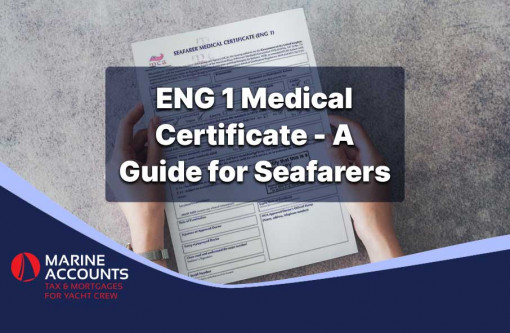
ENG 1 Medical Certificate - A Guide for Seafarers
If you're planning a career yachting, having a valid ENG 1 Medical Certificate is a must to prove you are fit and healthy to work at sea. Find out more about this health certificate and how to get one.

How to Get Into Yachting
Working on a superyacht has numerous appealing features, with various tax advantages associated with such a career move. But how do you get into yachting? Read our comprehensive article to find out.

A Complete Guide to Dockwalking
Dockwalking is the act walking along popular marina docks where superyachts are moored looking for work. But how do you get work on a yacht? Read on to find out how in our comprehensive guide.
Before you go...
You're about to visit a page on our legacy site. We're currently in the process of updating all our tax tools and while this page is still active please return to the main Marine Accounts site after completition.
Refer a friend and receive £50!
Upon successful completion of the referral the cash will be transferred to you.
Yacht Crew Job Board
With Bluewater's expertise in crew training and yacht crew recruitment, finding your ideal yacht crew vacancy is simple. We offer yacht management services to a variety of exclusive superyachts. Our team excels in sourcing top-notch yacht crew positions, spanning from 25-meter private yachts in the Bahamas to 50-metre charter yachts in the Mediterranean to luxurious 100+ metre superyachts navigating the globe extensively.
58 yacht crew jobs available now.
Yacht Crew Training
Alongside sourcing the latest yacht crew jobs worldwide, Bluewater offers a range of specialised yacht crew training courses. Whether you're new to the superyacht industry seeking entry-level qualifications, an experienced deckhand or engineer aiming to advance your career, or a dedicated crew member looking to enhance your resume with certifications like HELM (Human Element Leadership and Management), Yachtmaster, or OOW (Officer of the Watch), explore our comprehensive yacht crew training options.
Working on a Luxury Yacht
Working as a crew member on a superyacht is undeniably one of the most rewarding yet demanding professions, calling for hard work, dedication, and professional training. The opportunities within the yachting industry are vast, and at Bluewater, we are committed to helping every crew member discover their ideal yacht crew position. Our recruitment division focuses on finding the perfect yacht for crew members and provides unparalleled professional support. Our recruitment experts guide crew members through every step of their yachting career journey, ensuring they receive the best possible assistance.
Manage Your Yacht Career
Whether you're seeking a yacht crew position as a deckhand, engineer, onboard masseuse, stewardess, chef, chief stewardess, purser, first officer, or captain, take control of your yacht career. Create a profile and join one of the world's largest yachting communities for free.
58 JOBS FOUND

- Qualifications: Master 3000
- Experience: 10 years +
- Salary: Attractive salary (doe)
- Qualifications: STCW, ENG1, Food & Hygiene Level 2, Culinary Trained
- Experience: 1 Season +
- Salary: 3500EUR (DOE)
- Qualifications: STCW, ENG1, PDSD, PBL2
- Experience: 1 Year +
- Salary: 3000EUR
- Qualifications: Yachmaster Offshore or Deck Rating
- Qualifications: Y2
- Experience: 3 Years +
- Salary: 6000 to 6500EUR (DOE)
- Rotation 3:1
- Qualifications: STCW, ENG1, Food & Hygiene Level 2, Crowd Management Training, Crisis Management Training, PDSD, Hairdressing Qualifications
- Experience: 1 Year
- Salary: 3000EUR (DOE)
- Rotation (8:8 Weeks)
- Qualifications: ETO CoC preferred
- Experience: 2 years +
- Salary: 8000EUR
- Rotation 8:8 (Weeks)
- Qualifications: Y2 or Y3
- Salary: 5000EUR (DOE)
- Qualifications: STCW, ENG1, Seaman’s Book, Food Hygiene Level 2
- Salary: DOE
- 3 month on 1 month off
- Qualifications: STCW, ENG1 YM offshore
- Experience: -
- Salary: tbc
- Brokerage New Construction How to Buy How to Sell
- Yacht Fleet Yacht Catalog Charter Marketing Destination Guides
- Financial Services Payroll & Accounting Payroll Service Process Logistical Support Admin Services Crew Admin
- Job Descriptions Crew FAQ
- About Sitemap

- Yacht Department Directory
- Deck Department
Junior Deckhand
About the junior deckhand.
A junior deckhand is an entry level position that requires little to no experience on board luxury yachts, however, some experience with boats or watersports expertise is extremely valuable. What this crew member lacks in experience, they can make up for with a can-do attitude and being a strong team player. In this position, it is necessary to work closely with the senior deck officer, be a quick learner, and able to follow instructions thoroughly in a detailed manner.
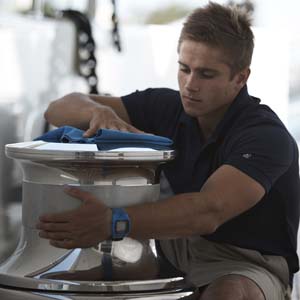
Job Responsibilities
- Cleanliness of the yacht wash downs, stainless polishing, waxing
- Assisting bosun and mate in maintenance projects; sanding and taping up for varnishing or painting, caulking, filling
- Continued learning of yacht maintenance, operations and systems; line handling, tender driving, navigation, safety, water sports
Required Skills
- Hard work ethic
- Positive attitude
- Ability to learn on the job
- Ability to take direction
- Professional appearance
Salary Modifiers
- Sports certification (i.e. dive certificate, kite surfing instructor)
- Extensive fishing knowledge
- Tender/small boat driving experience
- Carpentry skills
Position Statistics
Career path, senior master, junior captain, first officer / chief mate, officer of the watch.
Deckhand to master
Hello forum! I currently hold Mate of tow NC but work as a deckhand on a ship assist boat can I upgrade to master of tow from being a DH on a 2 man crew?
Related Topics
| Topic | Replies | Views | Activity | |
|---|---|---|---|---|
| Tugs & Towing | 13 | 4563 | February 6, 2016 | |
| Professional Mariner Forum | 4 | 1186 | October 24, 2019 | |
| Maritime Training & Licensing | 0 | 1088 | March 7, 2010 | |
| Professional Mariner Forum | 0 | 844 | September 15, 2014 | |
| Professional Mariner Forum | 1 | 3036 | February 5, 2009 |
Share this page
Deckhand in united states.
- Job ID #2372637
- Posted: 14th Jul 2024 by Captain
View all Vessel jobs
** 40m private motor yacht looking for a deckhand **
Please don't apply if you you do not have :
At least a seasons solid experience
Are in the USA, available immediately
Need to be legal to work in the US(B1/B2)
No visible tattoos.
Male only DTCA
Private program with a good work life balance as it’s not super busy but we still do run to a high standard and do things properly. You will be the work horse onboard and be able to work by yourself and keep motivation high. You will be on deck with a mate willing to teach and mould you into a solid yachtie. Plenty of room for growth and space for initiative a willingness to make things your own. We tow a 40ft heavy centre console that would be your project to drive and need to be comfortable and good at driving as you will be driving it a lot and it’s BRAND new.
In Newport finishing up the NE season 3-4 more boss trips to go then a yard period in Florida before Caribbean then over to the Med is the long term plan. Really nice owner that wants the boat and crew to look good at all times and does actually like the family vibe we have onboard and would like to keep it going with a long term deckhand to build and have under the mates wing.
- Vessel/Shorebased Type 39m (128ft)
- Vessel Type Motor Yacht
- Charter/Private Private
- Position Type Permanent Position
- Current Location United States
- Cruising Itinerary North Atlantic Ocean
- Homeport United States
- Yachting Experience 0 - 6 months
- Looking for Team/Couple No
- Posted 14th Jul 2024 by Captain
Language & Visas
- English Fluent
- Visas Green Card (or US Citizen) B1/B2
Qualifications
- Entry Level Qualifications (or equivalent) STCW 95 (STCW 2010) [Essential] ENG 1 (Medical Certificate) [Essential]
Interested?
Applying for this position is really simple, but you need to login first...
Login to Apply
- Weird But True
- Sex & Relationships
- Viral Trends
- Human Interest
- Fashion & Beauty
- Food & Drink
trending now in Lifestyle

Flyers can bring these 11 full-size liquids through airport...

I'm 60 — I slashed my biological age to 35 with four easy moves

Pregnant wife catches husband cozying up with another woman on...

I'm a weight loss coach — I live by these 4 simple wellness...

Dear Abby: My husband hasn't touched me since I gave birth 14...

Upstate NY car dealer goes viral with hilarious 'The Office'...

Gen Zer's snarky OOO work email goes viral: 'The guts these Gen Z...

Travel influencer falls 350 feet to death while filming at...
Breaking news, kylie and kendall jenner spark ultra-slim ‘yacht shoulders’ trend: ‘it’s insane’.
- View Author Archive
- Email the Author
- Get author RSS feed
Contact The Author
Thanks for contacting us. We've received your submission.
Thanks for contacting us. We've received your submission.

Trying to keep up with the Kardashians is an intense burden to shoulder .
EXTENDED Prime Day Deals!
Shop our curated guide to find the best deals before they are gone
But wannabe bombshells are shrugging off the heaviness of the lift to achieve K-inspired contours.
“Me after seeing Kylie and Kendall’s shoulders on the yacht in Mallorca,” said fitness influencer @ProteckPhilippe , or PP, in a TikTok clip of her grueling upper arm workout.

The brunette centered her sweat session around attaining the slenderized look of the A-list sisters, Kylie, 26, and Kendall, 28, who cut toned physiques while vacationing on a luxe cruiser off the coast of Spain in June.
“Yacht shoulders,” PP captioned the post, which muscled up over 7.6 million views from digital audiences — many of whom had a bone to pick with her for starting yet another Kardashian-spawned trend.
A newcomer to the body-modification movement, “yacht shoulders” are slim, chiseled shoulders accompanied by a slight neck and chicly prominent collar bone.
However, unlike the viral “TrapTox” craze, which sees beauty belles injecting Botox into their trapezius muscles for leaner looks, women of the yacht shoulders swing are flocking to the gym for the enviable exterior.

“Those yacht shoulders are pending!” vowed UK exercise content creator Natalie Rose while executing a weight-training workout.
deals are Dwindling!

EltaMD UV Clear Tinted Face Sunscreen

Laneige Lip Sleeping Mask

COLOR WOW Dream Coat Supernatural Spray
Health tastemaker Nathalie Jennings echoed Rose’s sentiments in a separate snippet of her own shoulder-sculpting routine on a machine.
Natalia, a lifestyle influencer, also took to TikTok, boasting , “So happy to announce that I do, in fact, have yacht shoulders,” she wrote in the closed captions of her post. “So blessed.”
But, unfortunately, not everyone sees the ultra-trim trend as a blessing.

“Arm and shoulder beauty standards is insane,” barked a detractor beneath PP’s viral video.
“Ummmm they also get Ozempic, tons of work and maintenance done,“ alleged another about the Kardashians.
“Love yourself,” a concerned commenter urged.
And a little self-love, coupled with a little less social media, might be just what the doctor ordered for some easily influenced young women.
In fact, a February 2023 study from the from the Children’s Hospital of Eastern Ontario Research Institute found that cutting a teen’s scrolling time in half can “significantly” improve their body imagine in weeks.
Alyssa McKay, 23, from Manhattan, previously told The Post that she immediately regretted undergoing a $7,000 breast augmentation in an attempt to mimic Kylie’s bountiful bust.
“When I got my boobs done, the beauty trend was all about having the Kardashian look — big boobs and a big butt,” she said of the voluptuous family.
@protekphilippe Yacht shoulders #shoulderworkout #kylie #kendal #mallorca #yacht #sculpt ♬ Kylieloverss – Kylielovers💋💋
“I wish I would have waited and thought about whether surgery was something I really wanted to do,” McKay continued.
“I just want to be happy with who I am and my body as it is.”

Advertisement

Get Onboard
Superyacht Training

How to Get a Deckhand Job on a Superyacht?
Traveling then working on a Superyacht could be perfect career for you. It’s no surprise that Super yachts spend all of their time in the sunny parts of the world. Generally, yachts spend the summer cruising around the Mediterranean and winter in the Caribbean.
The competition for deckhand jobs is getting fierce. There are some essential crew training certificates you must hold before you can get a deckhand job on a luxury yacht are:
1. STCW Basic Training
The STCW stands for Standards of Training, Certification and Watchkeeping. The STCW’2010, previously referred to as STCW’95, forms part of the basic safety training and is a compulsory requirement for any seafarer in order to be eligible for employment at sea. The STCW 2010 has replaced STCW 95 and is the new code that all seafarers working on board commercial vessels must adhere to should they are want to work at sea.
If you are planning on joining the super yacht industry to look for a yacht job as a stewardess, deckhand, engineer or chef, you will need to complete this STCW course.
2. ENG 1 (Seafarers Medical Certificate)
The ENG1 Medical is a basic medical certificate and is as essential as your STCW’10. It is a mandatory requirement to prove you are fit to work as a yacht crew member at sea. Only MCA-approved doctors can perform an ENG 1 medical exam
However Captains are now looking for that little bit extra, whether it’s a skill, a background in carpentry, experience with water sports, jet skis, power boats, sailing background, etc.
Tips to Become a Yacht Deckhand
How do I stand out as a Deckhand from the rest of the yacht crew? There are a number of things people can do to increase their chances of finding work as a yacht deckhand on a super yacht, for example having experience in any of the following mentioned tasks would be a distinct advantage over other entry level deckhands looking for a crew position.
Additional Superyacht Deckhand Courses:
1. MCA Yacht Rating Certificate
2. RYA Day Skipper
3. Powerboat Level 2
4. PWC Ticket
5. Mechanical skills
6. Scuba Diving and any other water sports instructor tickets (e.g Kite Surfing)
7. VHF/SRC Radio Operators Certificate
8. Exterior Maintenance such as varnishing, painting, fibreglass works, carpentry skills etc.
9. Photography or Drones are great hobbies
10. Personal Trainer qualifications
11. Navigation and Boat Handling skills
12. Carpentry, Mechanical and Engineering Skills
How To Become a Deckhand With No Experience?
If you have no experience in the super yacht industry, the first thing you will need to do is invest in our “Beginners Guide to Yachting” ebook. Having no experience doesn’t mean that you can’t ever land a Deckhand job. Captains have, in the past, hired crew with a variety of backgrounds such as Hospitality, Cruise Lines, recent Graduates, Mechanics, Engineers, Divers and anyone who can prove they have the willingness to learn with the right work ethic. Check out our article on how to find a job with no experience.
How much do I get paid to work on a Superyacht
Yacht salaries start from €2,000 a month for Deckhands and Stewardesses, rising to €4,000+ for more senior roles on luxury motor yachts. You live onboard the yacht so there are no living expenses. Meals are prepared by the Chef onboard, and you very rarely need to buy any groceries or toiletries. Read our guide how much you can earn working on super yacht.
What’s next?
The biggest quality the Superyacht Captain looks for is attitude. If you have a good, positive attitude then you will go far. Get Onboard Superyacht Academy can provide all the qualifications and skills you need to get going including detailed information on our Deckhand Course.
If you require additional advice on how to get a job as a Deckhand on a superyacht, please don’t hesitate to send us an email .
Needing more?
Error: Contact form not found.
RYA/MCA Online
1. what are the basic requirements you need to be eligible to work in the yachting industry, 2. what is the stcw and why do i need it, 3. what is the eng1 medical certificate, 4. what land based experience will help me find a super yacht job, 5. what are the different departments onboard, 6. what crew training is required for me to work as a junior deckhand.
- Yachtmaster/Coastal Skipper Theory
- Yachtmaster/Coastal Practical
- Specialist Super Yacht Training Course (Deck Hand Training Course)
- RYA Power Boat Level II
- RYA Personal Watercraft Course
- RYA Competent Crew Certificate
- RYA Day Skipper Theory and Practical Certificates
- VHF Radio Operator’s License
7. What crew training is required for me to work as a junior stewardess?
- Stewardess Course
- Proficiency in Designated Security Duties (PDSD)
- MCA Food Safety Level 2
- RYA Powerboat Level 2
8. How do I book my training courses?
9. how do i get my first job on a yacht, 10. are these courses worth it, or am i just wasting my money, 11. will i get hired for my first job from south africa, 12. what is daywork, 13. what are the best locations to get a yacht job, 14. how much can a motor yacht stewardess or deckhand earn, 15. what are the negatives of working on a yacht, 16. what are the positives of working on a yacht, 17. is working on a super yacht for everyone, 18. what is the minimum age to work on a yacht, 19. is accommodation provided when i am completing my yacht training in cape town.
Chop and Drop projects are happening across the state in wild trout waters. Here's why

Walking through a large tract of woods in Pennsylvania, you may be surprised to see that someone cut trees and dropped them into a stream.
Those fallen trees are part of an organized effort by many state and local agencies and nonprofit groups.
Large Wood Addition, sometimes called Chop and Drop, projects are happening in several parts of the state to mimic what Mother Nature would have provided if the lands were not clear-cut of timber more than 100 years ago.
“The projects in Pennsylvania have a number of purposes. First and foremost it’s to improve fish habitat with the focus on improving habitat for wild brook trout,” said Jason Detar, Pennsylvania Fish and Boat Commission fisheries manager for the northcentral region.
The benefits to the streams include retaking leaf litter, holding back silt and sediment that nourishes trees, providing food for insects, amphibians and fish, and reducing peak water flows during flooding.
This type of work is good for remote areas where it’s difficult to get heavy machinery near waterways.
“Where this really shines is in your typical forested watersheds where we have a lack of large wooden materials in the stream,” he said about the younger forests.
“What we are really looking to do with this is focus in on areas with small to middle-size streams where overhead cover and pool habitat is limited, and we are focusing on wild brook trout streams and watersheds,” Detar said. The upper Kettle Creek Watershed in northcentral Pennsylvania is a prime example of where these efforts have helped the waterway.
Work has also occurred in the northwestern part of the state in the Allegheny National Forest, in southcentral Pennsylvania in the Michaux State Forest. Chop and Drop work has also happened in southwestern Pennsylvania, including on Higgins Run in Somerset County.
Tree selection is a critical part of the work.
“Trees that are selected occur back away from the edge of the stream, so we usually look a few rows back from the edge of the stream. Oftentimes it’s a combination of tree sizes that are used,” Detar said.
They try to keep some of the tree on the bank to act as ballast to help keep the tree in place during high water events.
The projects require design and permitting work before the first chainsaws fire up.
“We are really trying to mimic Mother Nature in a natural occurrence of wood in the stream. But when each tree is selected for felling, it’s done in an organized manner with a goal in mind,” Detar said. On average they add wood to the streams about every 100 feet, but it varies from stream to stream.
One side benefit of the work is that many animals walk on the trees to cross streams. Additional benefits include reconnecting trees to floodplains during high-water events.
The trees break up the water flow and move water to low-lying areas. “It helps to dissipate the energy of the floodwater,” Detar said. “You get a lot more groundwater recharge and actually benefits to downstream peak flows because we are holding more water higher up in the watershed."
The woody material provides forage for insects that live in streams. The insects eat the wood and the fish eat the insects.
“There’s really a full ecosystem benefit of the large wood addition. What we do not want to do is open up the canopy as water temperature is the major limiting factor for trout streams,” Detar said about concerns of allowing more sunlight through to the water.
The deeper pools provide cover and protection for the fish from raptors and other predators.
Different groups making the work happen in their own unique ways. For example, he said the Western Pennsylvania Conservancy (WPC) uses a tool called a grip hoist to pull trees over to allow the root balls to be used as part of the work.
Down the road anglers should be finding more trout in the waters where this habitat is being made.
“It usually takes a couple years and a couple high-flow cycles for the wood to fully incorporate into the habitat,” Detar said.
More: BHA weighs in on Sunday hunting in Pennsylvania, improves wildlife habitat across Pa.
Western Pennsylvania Conservancy
Luke Bobnar, watershed projects manager, Upper Allegheny and Lake Erie for the Western Pennsylvania Conservancy , has been involved in Large Wood Addition projects for about a decade.
“It started small and has grown to the point where we are doing 10 to 20 miles a year,” Bobnar said.
“I see environmental benefits, but I also am a person and like people, so I see the people benefits, too. I’d say it’s a holistic way to treat a watershed,” Bobnar.
“I’ve primarily worked on the Allegheny National Forest . I’ve done over 40 miles of the National Forest, so it would be the Allegheny and Clarion river watersheds as well as Tionesta Creek."
Recently they’ve been working on the Farnsworth branch of Tionesta Creek.
He said the National Forest system has been doing this work for several decades and it’s now happening in the eastern part of the country. “We’re the boots on the ground but the National Forest is definitely the leader in saying we should do this here,” Bobnar said.
“Flooding is hugely important for these sites. Without floods it doesn’t work,” Bobnar said about retaining sediment and nutrients on the floodplain.
“In some instances, you are reactivating a relic side channel that had been, maybe there was a railroad put there and maybe due to historic forest clearing the main channel became entrenched and no longer access that side channel. Putting in some log jams might reactivate that side channel and that’s where your young fish grow or your amphibians or insects,” he explained.
Instead of one route of water going down the valley, the habitat work translates to multiple routes of water in different sizes that provide different types of habitat.
He’s been monitoring the success of his work and said a preliminary finding realized they created a quarter of an acre more of wetlands on a 14-acre area of treatment in the first eight months. “For wetland development, for something to officially become a wetland is usually a process that takes years. I’m really encouraged by those initial results,” Bobnar said.
Animals are walking on the downed trees to cross the streams and he’s aware of a trail camera project. “I think there were 15 or 20 different species that we saw cross the logs. From birds to mammals and amphibians, it was pretty cool,” Bobnar said. Earlier this year when there was a fresh snowfall, he saw bear tracks where one walked over a fallen tree.
Bobnar wants people to know that wood is good for rivers. “Streams aren’t meant to be straight and clear. They are meant to be messy and to our eyes chaotic. That’s where the habitat is. It’s better for the wildlife and what’s ultimately good for them is good for us, too.
“Everything benefits including people in downstream communities.”
Allegheny National Forest
Nathan Welker, aquatics program manager for the U.S. Forest Service in the Allegheny National Forest , remembers how Large Wood Addition projects started happening in the Keystone State.
“Myself and our forest hydrologist Charles Keeports actually were the first two to introduce Chop and Drop to the state of Pennsylvania,” Welker said. They learned about it in Vermont and New Hampshire and were able to train Pennsylvania crews, including the Western Pennsylvania Conservancy and the Fish and Boat Commission, about in 2015. Since then, he said groups have done “a ton of excellent work with it.”
The U.S. Forest Service partners with Trout Unlimited and the Western Pennsylvania Conservancy on projects. “WPC does the vast majority of the work on the Allegheny (National Forest). They have a dedicated crew that’s been on our forest for several years now and we have an agreement that helps to fund that work for them,” he said.
Before the work started, the streams had little variation in depths or flow patterns. “Fish actually need those for different stages of their life,” he said. “Freshwater trout need to be able to find refuge from predators, coldwater refuges, deepwater refuges for when the streams start to get low and when you basically have a uniform stream reach, those fish don’t have a lot of options when things start to turn against them,” Welker said. They also need areas suitable for reproduction as well.
“What we are doing is kind of the tip of the iceberg,” he said about comparing their projects to what would be found in an old-growth forest primitive stream channel.
Department of Conservation and Natural Resources
Our first project was in 2016 in the Kettle Creek watershed. And that’s pretty much where all of our work has been thus far,” said Troy Stimaker, assistant district forester, Resource Management, Susquehannock State Forest for the DCNR .
The work happens in late fall through spring when the leaves are off the trees and the fish aren’t spawning. “It’s a good time of the year for all of us in the agencies because we’re not as busy with our workload that time of the year,” he said.
It takes several years before they start seeing the true benefits of the work.
“We’ve learned a lot of what we’ve done in the past in terms of techniques that work the best in different size streams,” he said.
Planning and organization are key to finding the right places to pool water and collect sediment.
“We’re very particular about what species of tree," Stimaker said about the selection process. "Certain species of trees, that are little bit heavier, have better branching patterns and tend to gather material better and last a little longer, they don’t rot as fast.
His staff’s work is labor intensive with the crews using chainsaws and wedges. “We’re not using machinery at all,” he said.
The first few years of the work, he said they were able to use ash trees that had died from the Emerald ash borer infestation. “They were already dead or dying and they were prime targets, so we did use a lot of ash for habitat work,” he said.
They use heavy maple, oak and hemlock trees, sometimes in combination, across the water. The heavier trees keep the logs in place during high water times and the hemlocks have plenty of limbs to catch what’s flowing downstream. “It all depends on what species are there,” he said.
Efforts are underway to educate the public about this type of work. Stimaker said people driving by the creeks or hiking may see some interpretive panel signs that explain what the agencies and organizations have done. “Some people are probably wondering, especially fishermen, it does make the fishing harder for sure, because you have a lot more trees and branches in the stream, but it’s making the stream more productive as well,” he said.
Trout Unlimited’s efforts
Phil Thomas, stream restoration specialist for the Pennsylvania Coldwater Habitat Restoration Program of Trout Unlimited (TU) , has been involved with the organization for about nine years and has been involved with Large Wood Addition efforts over the past six years.
“It’s restoring it to how nature was before we logged everything in the 1800s,” he said.
“A lot of my work is in some very remote areas and being able to return that stream to what it was before we got here and removed all the trees off the landscape is a pretty cool tool to be able to use and all the benefits. I always tell people this is a watershed-wide approach. It’s not just a spot treatment of a site,” Thomas said.
“We’re doing it for the benefit of the brook trout, but it benefits the whole watershed from the brook trout all the way down to the bugs that the brook trout eat up to the raccoons feed on the fish and the deer that use the structures to bed next to and grouse that drums on top of it; to the fishers and bears that use the logs to traverse across the stream without getting wet."
The animals have responded quickly to the habitat improvements.
“We’ve actually been cutting one day and leave the job site and come back the next morning and we’ve pushed deer bedded out from underneath our structures that were cut the day before. It’s pretty wild how quickly, not only the fish respond to these structures, but the wildlife around it benefits as well,” Thomas said.
Trout Unlimited steers the work at various projects based on surveys and maps of the watersheds.
“TU will do some reconnaissance via computer to see where this may be warranted and do the on-ground recon to see if the watershed warrants this kind of work and we will also work with the landowner and other partners involved to fundraise,” Thomas said.
TU has worked in the Kettle Creek drainage area in some of its tributaries, in the Allegheny National Forest as well as in Clearfield County in a tributary to Mosquito Creek in Moshannon State Forest and on Game Commission property in the area. They also helped a private hunting club with a chop and drop project in Lycoming County on a tributary to Lycoming Creek. “We’ve been bouncing around a little bit here and there where we see a good project,” he said.
Depending on the location, county conservation districts and the Pa. Department of Environmental Protection are also involved in the permitting process, too. “It’s not haphazard,” he said about cutting trees in the forest.
This type of work is less expensive than the way agencies tried to get similar results in the past with traditional structures with log deflectors.
Those projects would cost $30 to $60 per linear foot because of the logs and machinery that was required. With Chop and Drop projects, the work is $10 or less per linear foot.
“It’s very inexpensive compared to the hardened structures that a lot of folks are used to. It’s very inexpensive and efficient and in my opinion, one of the best ways to increase the habitat complexity in a watershed,” Thomas said.
“We’re mimicking the natural succession of the forest. We’re giving the streams a jump-start until the forests reaches maturity and the (trees) start falling in on their own. If we do it right, it’s a one-time deal and then Mother Nature will take it from there.
“I’m not necessarily trying to make it better, but just trying to make it sustainable for the future. With climate change, I think without this technique being used that threat to these species, whether it’s brook or brown trout, I think the threat becomes a lot greater because they don’t have the habitat. They don’t have the cold water groundwater that’s being recharged in there in the summer."
The work is giving wild trout a better chance to flourish.
“The numbers and the size of the fish and the overall health of the watershed is definitely far greater than when we first started,” Thomas said. “They are better now because of this technique.”
With projects every couple hundred feet, stormwater is held back and reduces downstream flooding.
“There’s a whole host of things these projects can do,” he said. “They are very versatile.”
Brian Whipkey is the outdoors columnist for USA TODAY Network sites in Pennsylvania. Contact him at [email protected] and sign up for our weekly Go Outdoors PA newsletter email on this website's homepage under your login name. Follow him on Facebook @whipkeyoutdoors .

IMAGES
VIDEO
COMMENTS
About the Deckhand A deckhand is a position aboard with primary duties including cleaning and maintenance of the exterior of the vessel. Vessels will usually consider a successful candidate that already has experience in the superyacht industry and is keen to learn and work hard.
1. Understand the Training Requirements. The foundational step to becoming a deckhand in Australia is to complete the necessary safety training. While the training is broadly similar across different countries, there are specific requirements for those intending to work on commercial vessels within Australia:
One way to break into crew work is by getting real-world experience in the maritime world, adds Hollingshead. "Go and get a job in a marina, work for a boat-building company, learn about teak, painting, epoxy, etc. 10 Tips for Newbie Deckhands. "There are two main work/life experiences that I value in a candidate," he continues.
Go to a superyacht marina. 1. Have the right attitude. Along with gaining the correct qualifications to prove your competence, to become a Yachtie, you must have certain characteristics to thrive in this industry. Yachties have to be well presented, articulate, know how to take orders, and be able to work hard, all with a smile and enthusiasm.
A deckhand is a junior crew member on a boat or large ship. Being aware of your surroundings is crucial, as you work with lines and other equipment, being a part of the team that brings the ship alongside dock, or that maintains sea safety and lifesaving equipment. An essential Deckhand requirement is understanding the structure and hierarchy.
A Deckhand is an excellent place to start your career on board a superyacht as it gives you a good grounding in day-to-day operations. A Deckhand may choose to continue working in a deck role, and progress to the position of Bosun. Alternatively he/she may prefer to move into the Engineering department as an Engineer, or get into the Service ...
Step 2: Gain Experience. To become a certified deckhand, you must have experience working on yachts. One way to gain experience is to work as a day worker or a casual crew member. Day workers are typically hired daily to assist with various tasks on the yacht. Casual crew members are hired for short-term contracts and can gain valuable ...
A Deckhand's salary ranges between €2,000 to €3,500 a month, though the average is €2,500. Almost all Superyachts pay is in Euros. The salary can depend on many factors, the main one being the yacht's "crew" budget. The owner or management company will agree on a budget that the captain uses to hire crew.
A Deckhand is an entry-level role on a yacht, and their main responsibility is the maintenance and cleanliness of the exterior of the yacht. As a Deckhand gains experience onboard a vessel they can work their way towards becoming the Lead Deckhand, Bosun, Chief Officer, and ultimately the Captain.
Working in a team while learning from experienced crew members is the key to becoming a successful deckhand. Duties change depending on the yacht's schedule. This results in a wide range of responsibilities with emphasis on the cleanliness of the vessel, tender driving, lookout duties and general maintenance. 2.
We often get asked the question, what do I need to become a deckhand on a yacht. With no experience there are courses that you must take to ensure you are qualified to become a Superyacht deckhand. The certificates will also show the yacht agencies that you are a serious deckhand candidate looking for a job.
Job role of a Superyacht Deckhand. The deckhand position will encompass many responsibilities, but most importantly, he/she will maintain the exterior of the yacht and keep it in pristine condition at all times. Covering everything from the windows to sporting equipment, from changing sun lounger covers to varnishing the guard rails.
Creating a Deckhand Yacht CV. It is important in the yachting industry that you tailor your CV for the specific position you are looking for. Be sure to include any additional water sports or trade skills as this will help you star out from the crowd. Any relevant yachting experience should be included in a section clearly defined, and separate ...
In this video, we're going to learn how to get a job on a yacht as a deckhand, which is one of the 4 entry level yacht jobs that are options for new yacht cr...
hard work, dedication, and a willingness to learn are key factors in achieving success in the maritime industry. 6. Staying Safe and Adapting to Life at Sea as a Deckhand. Adapting to life at sea as a deckhand requires a strong focus on safety and the ability to quickly acclimate to the unique challenges of working on a vessel.
The key to becoming a successful deckhand is learning from experienced crew members as you work aboard an inland or large ship. Duties of a deckhand change depending on the schedule and function of a vessel. Deckhands are responsible for general maintenance, lookout duties, tender driving, and cleaning a ship. 4.
Superyachts operate on a hierarchical system and the deck department is no different. Depending on the size of the yacht, the deck team can be made up of a captain, officers, a bosun, senior/lead deckhands, standard deckhands as well as junior deckhands. This page focuses on the role of a superyacht deckhand and/or junior deckhand.
How to Become a Yacht Deckhand. If you wish to embark on a career in yachting, your starting point is to get a job as a junior deckhand. From then on you can hope to climb further up in the career ladder. One thing is for sure - you need to have a positive outlook and be willing to learn and to work hard.
Chief Officer - 44m Private Motor Yacht. Med. Permanent. Qualifications: Yachtmaster Offshore. Experience: 2 Years +. Salary: Industry standard. Apply. Next →. The latest yacht crew jobs available onboard exclusive charter yachts and luxury private yachts with leading yacht crew recruitment company, Bluewater.
A super yacht deckhand Deckhand is the entry-level position for crew who want to work on in the exterior department onboard a super yachts. A Deckhand's role will be is vast varies depending on the size of the vessel, however, the primary responsibility for a Deckhand is the meticulous cleaning and maintenance of the exterior of the yacht, which must be kept in pristine condition at all times.
A deckhand is an essential part of any Yacht crew team. Their primary goal is to make sure a yacht runs smoothly. Being a deckhand requires more than just being able to tie knots and look good in shorts. As a deckhand, you'll have the opportunity to work on some of the most glamorous yachts in the world while
Extensive fishing knowledge. Tender/small boat driving experience. Carpentry skills. Yacht Junior Deckhands have less than 1 year experience and are responsible for the Cleanliness of the yacht-wash downs, stainless polishing, waxing. They earn $26K - 29K based on yacht size & experience.
Deckhand required for a 50m M/Y. US Flag. Private. South Florida/Bahamas/NE . Work Experience Requirements: All applicants must have previous experience in working on a Yacht. Language Requirements: Good knowledge of the English language is required. Certificates and Qualifications:
Hello forum! I currently hold Mate of tow NC but work as a deckhand on a ship assist boat can I upgrade to master of tow from being a DH on a 2 man crew? Related Topics Topic Replies Views Activity; Apprentice Mate/Steersman Upgrade. Tugs & Towing. 13: 4563: February 6, 2016
** 40m private motor yacht looking for a deckhand ** Please don't apply if you you do not have : At least a seasons solid experience. Are in the USA, available immediately. Need to be legal to work in the US(B1/B2) No visible tattoos. Male only DTCA
"Kardashians" stars, Kylie, 26, and Kendall Jenner, 28, are at the center of the buzzy "yacht shoulders" trend, which sees wannabe bombshells on TikTok working out to achieve the A-lister's ...
The STCW 2010 has replaced STCW 95 and is the new code that all seafarers working on board commercial vessels must adhere to should they are want to work at sea. If you are planning on joining the super yacht industry to look for a yacht job as a stewardess, deckhand, engineer or chef, you will need to complete this STCW course. 2.
The work is giving wild trout a better chance to flourish. "The numbers and the size of the fish and the overall health of the watershed is definitely far greater than when we first started ...